一、哈希
1. 两数之和
-
题面:
给定一个整数数组
nums和一个整数目标值target,请你在该数组中找出 和为目标值target的那 两个 整数,并返回它们的数组下标。你可以假设每种输入只会对应一个答案,并且你不能使用两次相同的元素。
你可以按任意顺序返回答案。
- 只会存在一个有效答案
-
示例 1:
1
2
3输入:nums = [2,7,11,15], target = 9
输出:[0,1]
解释:因为 nums[0] + nums[1] == 9 ,返回 [0, 1] 。示例 2:
1
2输入:nums = [3,2,4], target = 6
输出:[1,2]示例 3:
1
2输入:nums = [3,3], target = 6
输出:[0,1]
暴力枚举肯定是可以的,但二重循环,时间复杂度高。
1 | class Solution { |
时间复杂度:.
空间复杂度:.
哈希表
1 | class Solution { |
时间复杂度:.
空间复杂度:.
2. 字母异位词分组
-
题面:
给你一个字符串数组,请你将 字母异位词 组合在一起。可以按任意顺序返回结果列表。
字母异位词 是由重新排列源单词的所有字母得到的一个新单词。
strs[i]仅包含小写字母
-
示例 1:
1
2输入: strs = ["eat", "tea", "tan", "ate", "nat", "bat"]
输出: [["bat"],["nat","tan"],["ate","eat","tea"]]示例 2:
1
2输入: strs = [""]
输出: [[""]]示例 3:
1
2输入: strs = ["a"]
输出: [["a"]]
字符串自身排序作为键
1 | class Solution { |
时间复杂度:.
空间复杂度:.
还可以计数 26 个字母出现的次数,成为一个数组,这个数组作为键。
写的太复杂,这里不给代码了。
3. 最长连续序列
-
题面:
给定一个未排序的整数数组
nums,找出数字连续的最长序列(不要求序列元素在原数组中连续)的长度。请你设计并实现时间复杂度为 的算法解决此问题。
-
示例 1:
1
2
3输入:nums = [100,4,200,1,3,2]
输出:4
解释:最长数字连续序列是 [1, 2, 3, 4]。它的长度为 4。示例 2:
1
2输入:nums = [0,3,7,2,5,8,4,6,0,1]
输出:9
注意点:
-
使用
unordered_set -
不要重复查找,有前序数字的数字肯定不会是最长序列的开端。
例如,有4,5,6,7,那么,5 肯定不会是最长序列的开端,同理,6,7也不会是。
怎么判断:看是不是存在前序数字即可,比如 5 看是不是存在 4。
1 | class Solution { |
时间复杂度:.
空间复杂度:.
二、双指针
4. 移动零
-
题面:
给定一个数组
nums,编写一个函数将所有 0 移动到数组的末尾,同时保持非零元素的相对顺序。请注意 ,必须在不复制数组的情况下原地对数组进行操作。
-
示例 1:
1
2输入: nums = [0,1,0,3,12]
输出: [1,3,12,0,0]示例 2:
1
2输入: nums = [0]
输出: [0]
双指针法
1 | class Solution { |
时间复杂度:.
空间复杂度:.
5. 盛最多水的容器
-
题面:
给定一个长度为
n的整数数组height。有n条垂线,第i条线的两个端点是(i, 0)和(i, height[i])。找出其中的两条线,使得它们与 x 轴共同构成的容器可以容纳最多的水。
返回容器可以储存的最大水量。
说明:你不能倾斜容器。
-
示例 1:
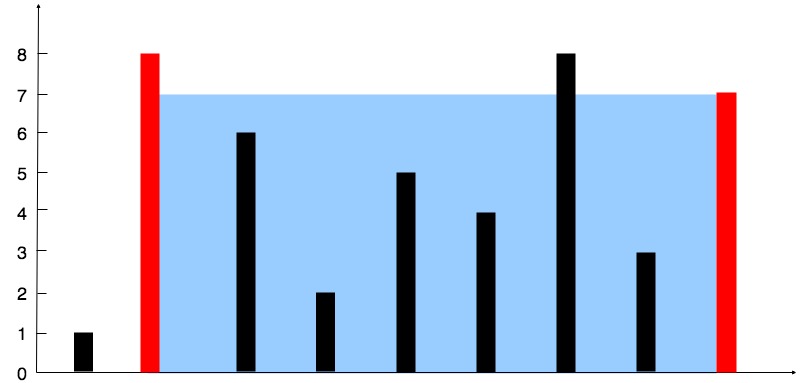
1
2
3输入:[1,8,6,2,5,4,8,3,7]
输出:49
解释:图中垂直线代表输入数组 [1,8,6,2,5,4,8,3,7]。在此情况下,容器能够容纳水(表示为蓝色部分)的最大值为 49。示例 2:
1
2输入:height = [1,1]
输出:1
关键在于思考怎么移动指针。
1 | class Solution { |
时间复杂度:.
空间复杂度:.
6. 三数之和
-
题面:
给你一个整数数组
nums,判断是否存在三元组[nums[i], nums[j], nums[k]]满足i != j、i != k且j != k,同时还满足nums[i] + nums[j] + nums[k] == 0。请你返回所有和为 0 且不重复的三元组。注意:答案中不可以包含重复的三元组。
-
示例 1:
1
2
3
4
5
6
7
8输入:nums = [-1,0,1,2,-1,-4]
输出:[[-1,-1,2],[-1,0,1]]
解释:
nums[0] + nums[1] + nums[2] = (-1) + 0 + 1 = 0 。
nums[1] + nums[2] + nums[4] = 0 + 1 + (-1) = 0 。
nums[0] + nums[3] + nums[4] = (-1) + 2 + (-1) = 0 。
不同的三元组是 [-1,0,1] 和 [-1,-1,2] 。
注意,输出的顺序和三元组的顺序并不重要。示例 2:
1
2
3输入:nums = [0,1,1]
输出:[]
解释:唯一可能的三元组和不为 0 。示例 3:
1
2
3输入:nums = [0,0,0]
输出:[[0,0,0]]
解释:唯一可能的三元组和为 0 。
三重循环查找不可避免。
- 查找时,同一个位置不能出现相同的数字,因此先排序是必要的。
- 可以发现,要
a+b+c = 0那么,确定a的情况下,b和c是对立的,此消彼长,因此不需要完完全全的三重循环,二重循环即可。 - 注意
c下标应该大于b下标。
1 | class Solution { |
时间复杂度:.
空间复杂度:. 主要是排序的消耗。
7. 接雨水
-
题面:
给定
n个非负整数表示每个宽度为1的柱子的高度图,计算按此排列的柱子,下雨之后能接多少雨水。 -
示例 1:
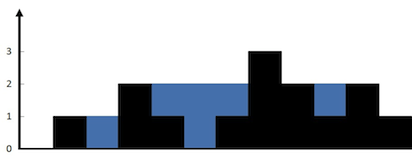
1
2
3输入:height = [0,1,0,2,1,0,1,3,2,1,2,1]
输出:6
解释:上面是由数组 [0,1,0,2,1,0,1,3,2,1,2,1] 表示的高度图,在这种情况下,可以接 6 个单位的雨水(蓝色部分表示雨水)。示例 2:
1
2输入:height = [4,2,0,3,2,5]
输出:9
动态规划
1 | class Solution { |
时间复杂度:.
空间复杂度:.
双指针,可以降低空间复杂度
1 | class Solution { |
时间复杂度:.
空间复杂度:.
三、滑动窗口
8. 无重复字符的最长子串
-
题面:
给定一个字符串 s ,请你找出其中不含有重复字符的 最长 子串 的长度。
子串:是字符串中连续的 非空 字符序列。
-
示例 1:
1
2
3输入: s = "abcabcbb"
输出: 3
解释: 因为无重复字符的最长子串是 "abc",所以其长度为 3。示例 2:
1
2
3输入: s = "bbbbb"
输出: 1
解释: 因为无重复字符的最长子串是 "b",所以其长度为 1。示例 3:
1
2
3
4输入: s = "pwwkew"
输出: 3
解释: 因为无重复字符的最长子串是 "wke",所以其长度为 3。
请注意,你的答案必须是 子串 的长度,"pwke" 是一个子序列,不是子串。
1 | class Solution { |
9. 找到字符串中所有字母异位词
-
题面:
给定两个字符串
s和p,找到s中所有p的 异位词 的子串,返回这些子串的起始索引。不考虑答案输出的顺序。
-
示例 1:
1
2
3
4
5输入: s = "cbaebabacd", p = "abc"
输出: [0,6]
解释:
起始索引等于 0 的子串是 "cba", 它是 "abc" 的异位词。
起始索引等于 6 的子串是 "bac", 它是 "abc" 的异位词。示例 2:
1
2
3
4
5
6输入: s = "abab", p = "ab"
输出: [0,1,2]
解释:
起始索引等于 0 的子串是 "ab", 它是 "ab" 的异位词。
起始索引等于 1 的子串是 "ba", 它是 "ab" 的异位词。
起始索引等于 2 的子串是 "ab", 它是 "ab" 的异位词。
1 | class Solution { |
四、子串
10. 和为 K 的子数组
-
题面:
给你一个整数数组
nums和一个整数k,请你统计并返回 该数组中和为k的子数组的个数 。子数组是数组中元素的连续非空序列。
-
示例 1:
1
2输入:nums = [1,1,1], k = 2
输出:2示例 2:
1
2输入:nums = [1,2,3], k = 3
输出:2
首先,朴素做法:
不佳,会报出:超出内存限制。
1 | class Solution { |
时间复杂度:.
空间复杂度:.
改进变量使用:
1 | class Solution { |
时间复杂度:.
空间复杂度:.
只求前缀和,并且用哈希表存储:
1 | class Solution { |
时间复杂度:.
空间复杂度:.
11.滑动窗口最大值
-
题面:
给你一个整数数组
nums,有一个大小为k的滑动窗口从数组的最左侧移动到数组的最右侧。你只可以看到在滑动窗口内的k个数字。滑动窗口每次只向右移动一位。返回 滑动窗口中的最大值 。
-
示例 1:
1
2
3
4
5
6
7
8
9
10
11输入:nums = [1,3,-1,-3,5,3,6,7], k = 3
输出:[3,3,5,5,6,7]
解释:
滑动窗口的位置 最大值
--------------- -----
[1 3 -1] -3 5 3 6 7 3
1 [3 -1 -3] 5 3 6 7 3
1 3 [-1 -3 5] 3 6 7 5
1 3 -1 [-3 5 3] 6 7 5
1 3 -1 -3 [5 3 6] 7 6
1 3 -1 -3 5 [3 6 7] 7示例 2:
1
2输入:nums = [1], k = 1
输出:[1]
朴素做法,超出时间限制:
1 | class Solution { |
时间复杂度:.
空间复杂度:.
优先队列是最应该想到的正确方法:
1 | class Solution { |
时间复杂度:.
空间复杂度:.
优化算法,可以只用单调队列(要用双端队列,队头队尾都能插入删除,但人为保持单调特性)
1 | class Solution { |
时间复杂度:.
空间复杂度:.
12. 最小覆盖子串
-
题面:
给你一个字符串
s、一个字符串t。返回s中涵盖t所有字符的最小子串。如果s中不存在涵盖t所有字符的子串,则返回空字符串""。注意:
- 对于
t中重复字符,我们寻找的子字符串中该字符数量必须不少于t中该字符数量。 - 如果
s中存在这样的子串,我们保证它是唯一的答案。
- 对于
-
示例 1:
1
2
3输入:s = "ADOBECODEBANC", t = "ABC"
输出:"BANC"
解释:最小覆盖子串 "BANC" 包含来自字符串 t 的 'A'、'B' 和 'C'。示例 2:
1
2
3输入:s = "a", t = "a"
输出:"a"
解释:整个字符串 s 是最小覆盖子串。示例 3:
1
2
3
4输入: s = "a", t = "aa"
输出: ""
解释: t 中两个字符 'a' 均应包含在 s 的子串中,
因此没有符合条件的子字符串,返回空字符串。
- 哈希表的数量检测不可避免
- 滑动窗口,右指针
r扩大,直到check true。再左指针l缩小,直到check false。
1 | class Solution { |
时间复杂度:.
空间复杂度:.
五、普通数组
13. 最大子数组和
-
题面:
给你一个整数数组 nums ,请你找出一个具有最大和的连续子数组(子数组最少包含一个元素),返回其最大和。
子数组 是数组中的一个连续部分。
**进阶:**如果你已经实现复杂度为
O(n)的解法,尝试使用更为精妙的 分治法 求解。 -
示例 1:
1
2
3输入:nums = [-2,1,-3,4,-1,2,1,-5,4]
输出:6
解释:连续子数组 [4,-1,2,1] 的和最大,为 6 。示例 2:
1
2输入:nums = [1]
输出:1示例 3:
1
2输入:nums = [5,4,-1,7,8]
输出:23
滑动窗口,自己想的
1 | class Solution { |
时间复杂度:.
空间复杂度:.
不用记录那么多,动态规划即可
1 | class Solution { |
时间复杂度:.
空间复杂度:.
14. 合并区间
-
题面:
以数组
intervals表示若干个区间的集合,其中单个区间为 。请你合并所有重叠的区间,并返回 一个不重叠的区间数组,该数组需恰好覆盖输入中的所有区间 。 -
示例 1:
1
2
3输入:intervals = [[1,3],[2,6],[8,10],[15,18]]
输出:[[1,6],[8,10],[15,18]]
解释:区间 [1,3] 和 [2,6] 重叠, 将它们合并为 [1,6].示例 2:
1
2
3输入:intervals = [[1,4],[4,5]]
输出:[[1,5]]
解释:区间 [1,4] 和 [4,5] 可被视为重叠区间。
时间安排问题,都是先按照开始时间排序再合并。
1 | class Solution { |
时间复杂度:.
空间复杂度:.
15. 轮转数组
-
题面:
给定一个整数数组
nums,将数组中的元素向右轮转k个位置,其中k是非负数。进阶:
尽可能想出更多的解决方案,至少有 三种 不同的方法可以解决这个问题。
你可以使用空间复杂度为 的 原地 算法解决这个问题吗? -
示例 1:
1
2
3
4
5
6输入: nums = [1,2,3,4,5,6,7], k = 3
输出: [5,6,7,1,2,3,4]
解释:
向右轮转 1 步: [7,1,2,3,4,5,6]
向右轮转 2 步: [6,7,1,2,3,4,5]
向右轮转 3 步: [5,6,7,1,2,3,4]示例 2:
1
2
3
4
5输入:nums = [-1,-100,3,99], k = 2
输出:[3,99,-1,-100]
解释:
向右轮转 1 步: [99,-1,-100,3]
向右轮转 2 步: [3,99,-1,-100]
1 | class Solution { |
时间复杂度:.
空间复杂度:.
1 | class Solution { |
时间复杂度:.
空间复杂度:.
16. 除自身以外数组的乘积
-
题面:
给你一个整数数组
nums,返回 数组answer,其中answer[i]等于nums中除nums[i]之外其余各元素的乘积 。题目数据 保证 数组
nums之中任意元素的全部前缀元素和后缀的乘积都在 32 位 整数范围内。请 **不要使用除法,**且在
O(n)时间复杂度内完成此题。进阶:你可以在 O(1) 的额外空间复杂度内完成这个题目吗?( 出于对空间复杂度分析的目的,输出数组 不被视为 额外空间。)
-
示例 1:
1
2输入: nums = [1,2,3,4]
输出: [24,12,8,6]示例 2:
1
2输入: nums = [-1,1,0,-3,3]
输出: [0,0,9,0,0]
1 | class Solution { |
时间复杂度:.
空间复杂度:.
但是违规了,题目要求不能除法。
1 | class Solution { |
时间复杂度:.
空间复杂度:.
1 | class Solution { |
时间复杂度:.
空间复杂度:.
17. 缺失的第一个正数
-
题面:
给你一个未排序的整数数组
nums,请你找出其中没有出现的最小的正整数。请你实现时间复杂度为
O(n)并且只使用常数级别额外空间的解决方案。 -
示例 1:
1
2
3输入:nums = [1,2,0]
输出:3
解释:范围 [1,2] 中的数字都在数组中。示例 2:
1
2
3输入:nums = [3,4,-1,1]
输出:2
解释:1 在数组中,但 2 没有。示例 3:
1
2
3输入:nums = [7,8,9,11,12]
输出:1
解释:最小的正数 1 没有出现。
1 | class Solution { |
时间复杂度:.
空间复杂度:.
1 | class Solution { |
时间复杂度:.
空间复杂度:.
1 | class Solution { |
时间复杂度:.
空间复杂度:.
1 | class Solution { |
时间复杂度:.
空间复杂度:.
18. 矩阵置零
-
题面:
给定一个 m x n 的矩阵,如果一个元素为 0 ,则将其所在行和列的所有元素都设为 0 。
请使用 原地 算法。
进阶:
- 一个直观的解决方案是使用
O(m*n)的额外空间,但这并不是一个好的解决方案。 - 一个简单的改进方案是使用
O(m + n)的额外空间,但这仍然不是最好的解决方案。 - 你能想出一个仅使用常量空间的解决方案吗?
- 一个直观的解决方案是使用
-
示例 1:
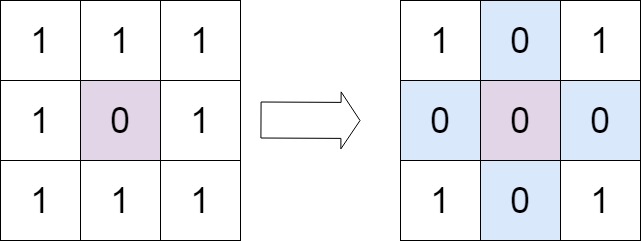
1
2输入:matrix = [[1,1,1],[1,0,1],[1,1,1]]
输出:[[1,0,1],[0,0,0],[1,0,1]]示例 2:

1
2输入:matrix = [[0,1,2,0],[3,4,5,2],[1,3,1,5]]
输出:[[0,0,0,0],[0,4,5,0],[0,3,1,0]]
1 | class Solution { |
时间复杂度:.
空间复杂度:.
19. 螺旋矩阵
-
题面:
给你一个 m 行 n 列的矩阵 matrix ,请按照 顺时针螺旋顺序 ,返回矩阵中的所有元素。
-
示例 1:
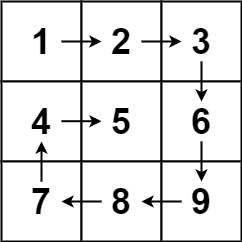
1
2输入:matrix = [[1,2,3],[4,5,6],[7,8,9]]
输出:[1,2,3,6,9,8,7,4,5]示例 2:
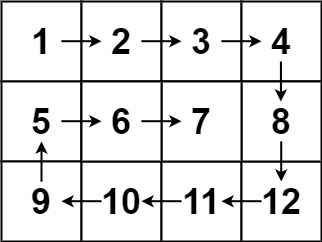
1
2输入:matrix = [[1,2,3,4],[5,6,7,8],[9,10,11,12]]
输出:[1,2,3,4,8,12,11,10,9,5,6,7]1
2
3
4
5
6
7
8
9
10
11
12
13
14
15
16
17
18
19
20
21
22
23
24
25
26
27
28
29
30
31
32
33
34
35
36
37
38
39
40class Solution {
public:
vector<int> spiralOrder(vector<vector<int>>& matrix) {
int m = matrix.size(), n = matrix[0].size();
int count = 0;
// flag 指示当前的运动方向
int i = 0, j = 0, flag = 1;
// 分别记录行列的边界 ist ied 行开始 结束 jst jed 列开始 结束
int ist = 0, ied = m, jst = 0, jed = n;
vector<int> ans;
while(count < m * n){
ans.push_back(matrix[i][j]);
switch(flag){
// 从左到右
case 1:
j++;
if(j >= jed) j = jed-1, i++, flag = 2, ist++;
break;
// 从上到下
case 2:
i++;
if(i >= ied) i = ied-1, j--, flag = 3, jed--;
break;
// 从右到左
case 3:
j--;
if(j < jst) j = jst, i--, flag = 4, ied--;
break;
// 从下到上
case 4:
i--;
if(i < ist) i = ist, j++, flag = 1, jst++;
break;
}
// 根据已输出的数量判断是否结束
count++;
}
return ans;
}
};时间复杂度:.
空间复杂度:.
20. 旋转图像
-
题面:
给定一个 n × n 的二维矩阵 matrix 表示一个图像。请你将图像顺时针旋转 90 度。
你必须在 原地 旋转图像,这意味着你需要直接修改输入的二维矩阵。请不要 使用另一个矩阵来旋转图像。
-
示例 1:
.jpg)
1
2输入:matrix = [[1,2,3],[4,5,6],[7,8,9]]
输出:[[7,4,1],[8,5,2],[9,6,3]]示例 2:
.jpg)
1
2输入:matrix = [[5,1,9,11],[2,4,8,10],[13,3,6,7],[15,14,12,16]]
输出:[[15,13,2,5],[14,3,4,1],[12,6,8,9],[16,7,10,11]]
1 | class Solution { |
时间复杂度:.
空间复杂度:.
1 | class Solution { |
时间复杂度:.
空间复杂度:.
1 | class Solution { |
时间复杂度:.
空间复杂度:.
21. 搜索二维矩阵 II
-
题面:
编写一个高效的算法来搜索 m x n 矩阵 matrix 中的一个目标值 target 。该矩阵具有以下特性:
- 每行的元素从左到右升序排列。
- 每列的元素从上到下升序排列。
-
示例 1:
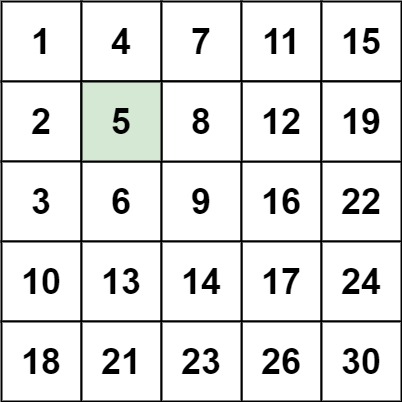
1
2输入:matrix = [[1,4,7,11,15],[2,5,8,12,19],[3,6,9,16,22],[10,13,14,17,24],[18,21,23,26,30]], target = 5
输出:true示例 2:
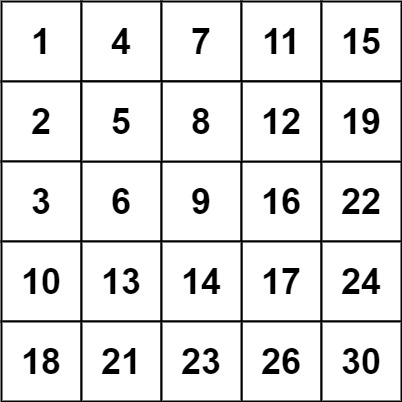
1
2输入:matrix = [[1,4,7,11,15],[2,5,8,12,19],[3,6,9,16,22],[10,13,14,17,24],[18,21,23,26,30]], target = 20
输出:false
1 | class Solution { |
时间复杂度:.
空间复杂度:.
1 | class Solution { |
时间复杂度:.
空间复杂度:.
1 | class Solution { |
时间复杂度:.
空间复杂度:.
六、链表
22. 相交链表
-
题面:
给你两个单链表的头节点 headA 和 headB ,请你找出并返回两个单链表相交的起始节点。如果两个链表不存在相交节点,返回 null 。
图示两个链表在节点 c1 开始相交:

题目数据 保证 整个链式结构中不存在环。
注意,函数返回结果后,链表必须 保持其原始结构 。
1 | /** |
时间复杂度:.
空间复杂度:.
1 | /** |
时间复杂度:.
空间复杂度:.
23. 反转链表
-
题面:
给你单链表的头节点 head ,请你反转链表,并返回反转后的链表。 -
示例 1:
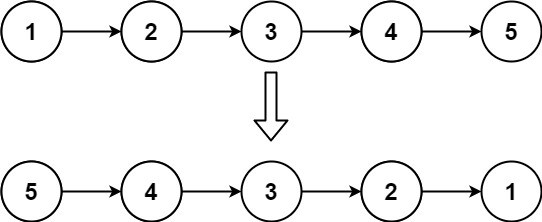
1 | /** |
时间复杂度:.
空间复杂度:.
24. 回文链表
-
题面:
给你一个单链表的头节点 head ,请你判断该链表是否为回文链表。如果是,返回 true ;否则,返回 false 。 -
示例 1:

1 | /** |
时间复杂度:.
空间复杂度:.
25. 环形链表
-
题面:
给你一个链表的头节点 head ,判断链表中是否有环。如果链表中存在环 ,则返回 true 。 否则,返回 false 。

1 | /** |
时间复杂度:.
空间复杂度:.
1 | /** |
时间复杂度:.
空间复杂度:.
26. 环形链表 II
-
题面:
给定一个链表的头节点 head ,返回链表开始入环的第一个节点。 如果链表无环,则返回 null。
不允许修改 链表。

1 | /** |
时间复杂度:.
空间复杂度:.
1 | /** |
时间复杂度:.
空间复杂度:.
27. 合并两个有序链表
-
题面:
将两个升序链表合并为一个新的 升序 链表并返回。新链表是通过拼接给定的两个链表的所有节点组成的。
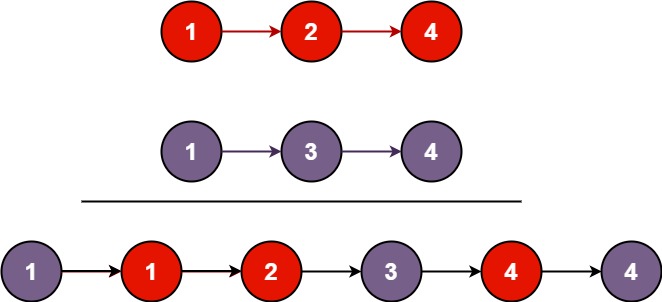
1 | /** |
时间复杂度:.
空间复杂度:.
1 | /** |
时间复杂度:.
空间复杂度:.
28. 两数相加
-
题面:
给你两个 非空 的链表,表示两个非负的整数。它们每位数字都是按照 逆序 的方式存储的,并且每个节点只能存储 一位 数字。请你将两个数相加,并以相同形式返回一个表示和的链表。
-
示例:
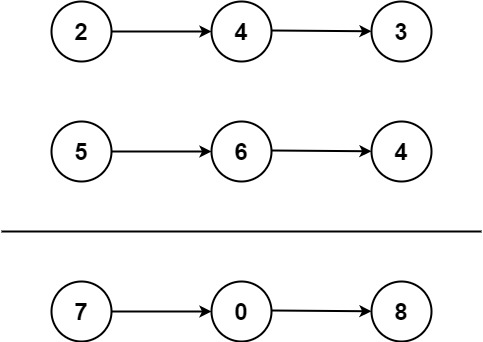
1
2
3输入:l1 = [2,4,3], l2 = [5,6,4]
输出:[7,0,8]
解释:342 + 465 = 807.
1 | /** |
时间复杂度:.
空间复杂度:.
29. 删除链表的倒数第 N 个结点
-
题面:
给你一个链表,删除链表的倒数第 n 个结点,并且返回链表的头结点。
-
示例:
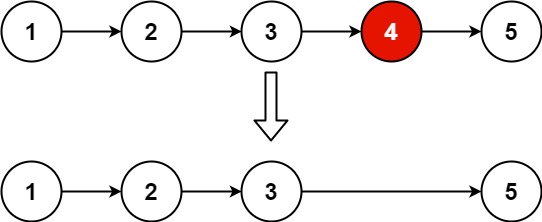
1
2输入:head = [1,2,3,4,5], n = 2
输出:[1,2,3,5]
1 | /** |
时间复杂度:.
空间复杂度:.
1 | /** |
时间复杂度:.
空间复杂度:.
1 | /** |
时间复杂度:.
空间复杂度:.
30. 两两交换链表中的节点
-
题面:
给你一个链表,两两交换其中相邻的节点,并返回交换后链表的头节点。你必须在不修改节点内部的值的情况下完成本题(即,只能进行节点交换)。
-
示例:

1 | /** |
时间复杂度:.
空间复杂度:.
1 | /** |
时间复杂度:.
空间复杂度:.
31. K 个一组翻转链表
-
题面:
给你链表的头节点 head ,每 k 个节点一组进行翻转,请你返回修改后的链表。
k 是一个正整数,它的值小于或等于链表的长度。如果节点总数不是 k 的整数倍,那么请将最后剩余的节点保持原有顺序。
你不能只是单纯的改变节点内部的值,而是需要实际进行节点交换。
-
示例:

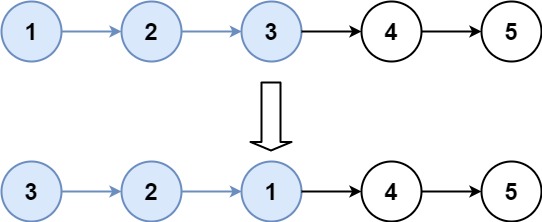
1 | /** |
时间复杂度:.
空间复杂度:.
32. 随机链表的复制
-
题面:
给你一个长度为 n 的链表,每个节点包含一个额外增加的随机指针 random ,该指针可以指向链表中的任何节点或空节点。
构造这个链表的 深拷贝。 深拷贝应该正好由 n 个 全新 节点组成,其中每个新节点的值都设为其对应的原节点的值。新节点的 next 指针和 random 指针也都应指向复制链表中的新节点,并使原链表和复制链表中的这些指针能够表示相同的链表状态。复制链表中的指针都不应指向原链表中的节点 。
例如,如果原链表中有 X 和 Y 两个节点,其中 X.random --> Y 。那么在复制链表中对应的两个节点 x 和 y ,同样有 x.random --> y 。如果不指向任何节点,则为 null 。
返回复制链表的头节点。
你的代码 只 接受原链表的头节点 head 作为传入参数。
-
示例:



1 | /* |
时间复杂度:.
空间复杂度:.
33. 排序链表
-
题面:
给你链表的头结点 head ,请将其按 升序 排列并返回 排序后的链表 。
-
示例:
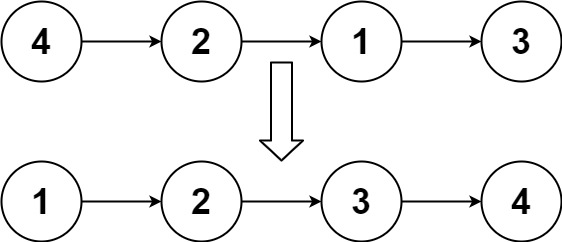
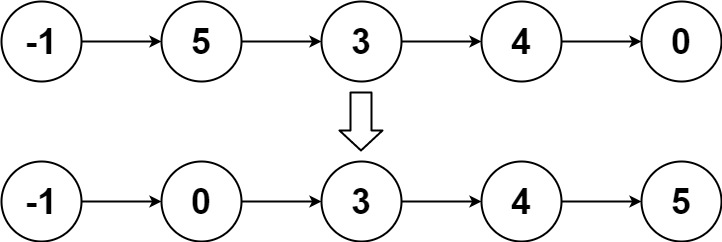
插入排序,超出时间限制。
1 | /** |
时间复杂度:.
空间复杂度:.
归并排序,可以。
1 | /** |
时间复杂度:.
空间复杂度:.
注:若改为自底向上归并排序,还可以空间复杂度降为 ,但是没必要。
参考:链接
耍赖也未尝不可!
1 | /** |
时间复杂度:.
空间复杂度:.
34. 合并 K 个升序链表
-
题面:
给你一个链表数组,每个链表都已经按升序排列。
请你将所有链表合并到一个升序链表中,返回合并后的链表。
-
示例:
1
2
3
4
5
6
7
8
9
10输入:lists = [[1,4,5],[1,3,4],[2,6]]
输出:[1,1,2,3,4,4,5,6]
解释:链表数组如下:
[
1->4->5,
1->3->4,
2->6
]
将它们合并到一个有序链表中得到。
1->1->2->3->4->4->5->6
1 | /** |
时间复杂度:.
空间复杂度:.
耍赖未尝不可。
1 | /** |
时间复杂度:.
空间复杂度:.
35. LRU 缓存
-
题面:
请你设计并实现一个满足 LRU (最近最少使用) 缓存 约束的数据结构。
实现LRUCache类:
LRUCache(int capacity)以 正整数 作为容量capacity初始化 LRU 缓存
int get(int key)如果关键字key存在于缓存中,则返回关键字的值,否则返回-1。
void put(int key, int value)如果关键字key已经存在,则变更其数据值value;如果不存在,则向缓存中插入该组key-value。如果插入操作导致关键字数量超过capacity,则应该 逐出 最久未使用的关键字。
函数get和put必须以O(1)的平均时间复杂度运行。 -
示例:
1
2
3
4
5
6
7
8
9
10
11
12
13
14
15
16
17输入
["LRUCache", "put", "put", "get", "put", "get", "put", "get", "get", "get"]
[[2], [1, 1], [2, 2], [1], [3, 3], [2], [4, 4], [1], [3], [4]]
输出
[null, null, null, 1, null, -1, null, -1, 3, 4]
解释
LRUCache lRUCache = new LRUCache(2);
lRUCache.put(1, 1); // 缓存是 {1=1}
lRUCache.put(2, 2); // 缓存是 {1=1, 2=2}
lRUCache.get(1); // 返回 1
lRUCache.put(3, 3); // 该操作会使得关键字 2 作废,缓存是 {1=1, 3=3}
lRUCache.get(2); // 返回 -1 (未找到)
lRUCache.put(4, 4); // 该操作会使得关键字 1 作废,缓存是 {4=4, 3=3}
lRUCache.get(1); // 返回 -1 (未找到)
lRUCache.get(3); // 返回 3
lRUCache.get(4); // 返回 4
1 | // 本题需要设计数据结构 |
时间复杂度:put和get均为.
空间复杂度:.
七、二叉树
36. 二叉树的中序遍历
-
题面:
给定一个二叉树的根节点 root ,返回 它的 中序 遍历 。
-
示例:
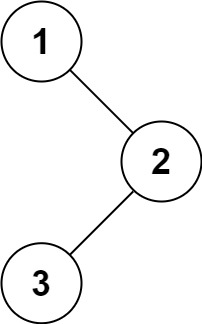
1
2输入:root = [1,null,2,3]
输出:[1,3,2]
1 | /** |
时间复杂度:.
空间复杂度:.
37. 二叉树的最大深度
-
题面:
给定一个二叉树
root,返回其最大深度。二叉树的 最大深度 是指从根节点到最远叶子节点的最长路径上的节点数。
-
示例:
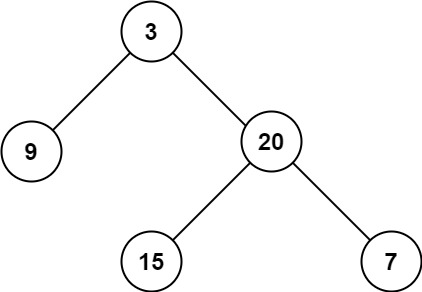
1
2输入:root = [3,9,20,null,null,15,7]
输出:3
DFS
1 | /** |
时间复杂度:.
空间复杂度:.
BFS
1 | /** |
时间复杂度:.
空间复杂度:.
38. 翻转二叉树
-
题面:
给你一棵二叉树的根节点
root,翻转这棵二叉树,并返回其根节点。 -
示例:

1 | /** |
时间复杂度:.
空间复杂度:.
39. 对称二叉树
-
题面:
给你一个二叉树的根节点
root, 检查它是否轴对称。 -
示例:
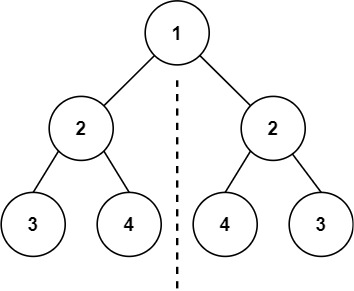
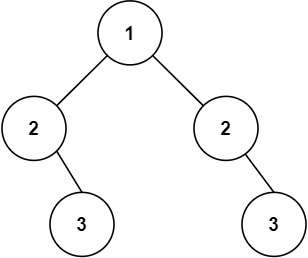
自己想的使用栈的方法。
1 | /** |
时间复杂度:.
空间复杂度:.
递归方法,复杂度是一样的,但是逻辑更巧妙。
1 | /** |
时间复杂度:.
空间复杂度:.
40. 二叉树的直径
-
题面:
给你一棵二叉树的根节点,返回该树的
直径。二叉树的 直径 是指树中任意两个节点之间最长路径的
长度。这条路径可能经过也可能不经过根节点root。两节点之间路径的
长度由它们之间边数表示。 -
示例:
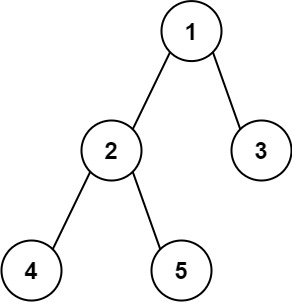
1
2
3输入:root = [1,2,3,4,5]
输出:3
解释:3 ,取路径 [4,2,1,3] 或 [5,2,1,3] 的长度。
1 | /** |
时间复杂度:.
空间复杂度:.
41. 二叉树的层序遍历
-
题面:
给你二叉树的根节点
root,返回其节点值的层序遍历。 (即逐层地,从左到右访问所有节点)。 -
示例:
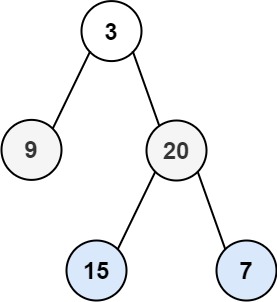
1
2输入:root = [3,9,20,null,null,15,7]
输出:[[3],[9,20],[15,7]]
1 | /** |
时间复杂度:.
空间复杂度:.
1 | /** |
时间复杂度:.
空间复杂度:.
42. 将有序数组转换为二叉搜索树
-
题面:
给你一个整数数组
nums,其中元素已经按升序排列,请你将其转换为一棵 平衡 二叉搜索树。平衡二叉树是指该树所有节点的左右子树的深度相差不超过 1。 -
示例:
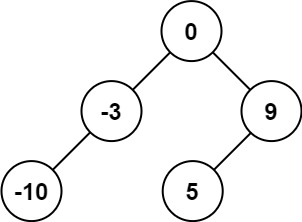
1
2
3输入:nums = [-10,-3,0,5,9]
输出:[0,-3,9,-10,null,5]
解释:[0,-10,5,null,-3,null,9] 也将被视为正确答案: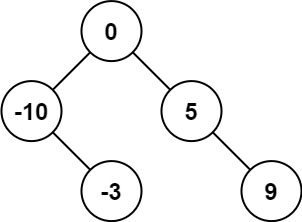
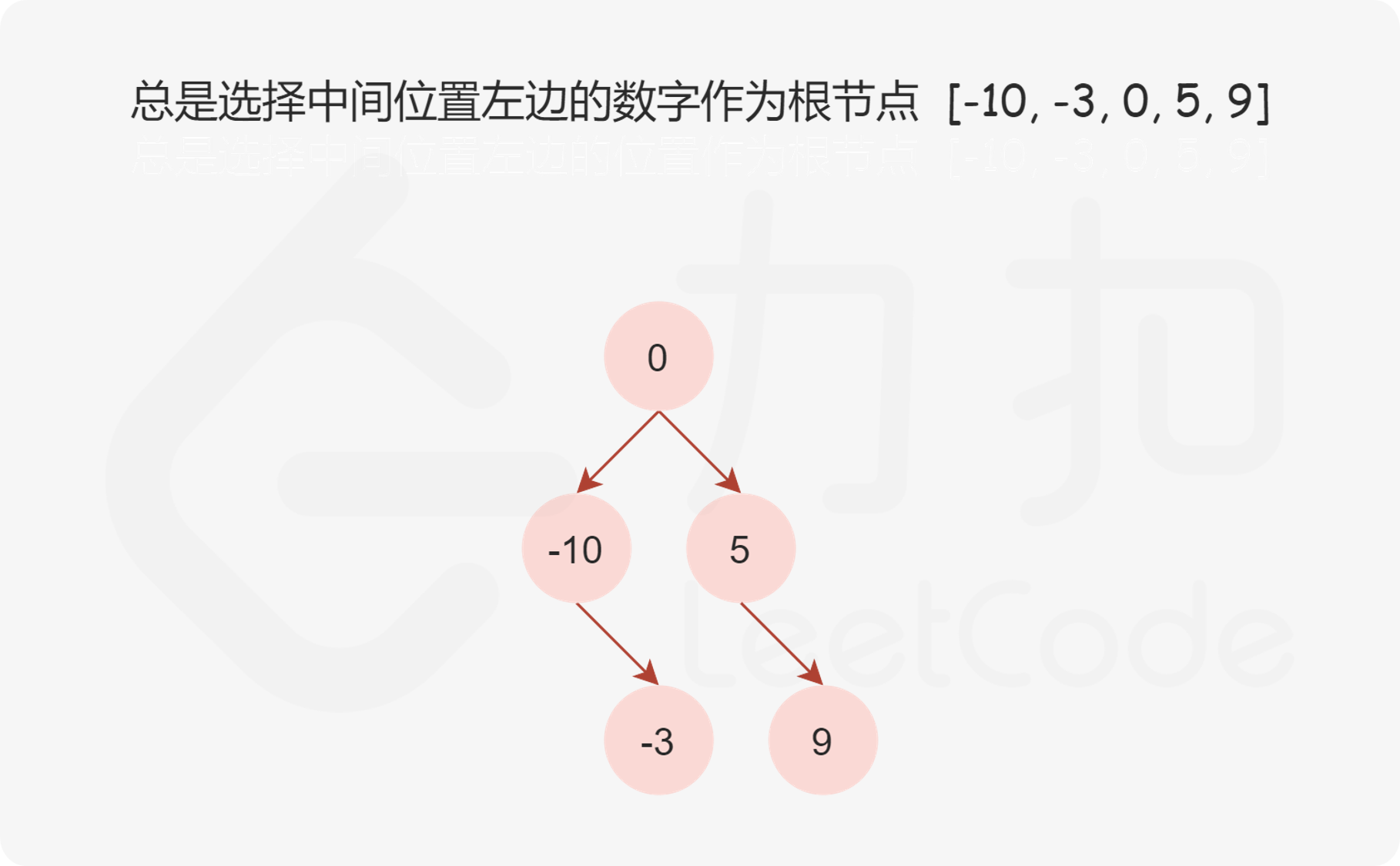
1 | /** |
时间复杂度:.
空间复杂度:.
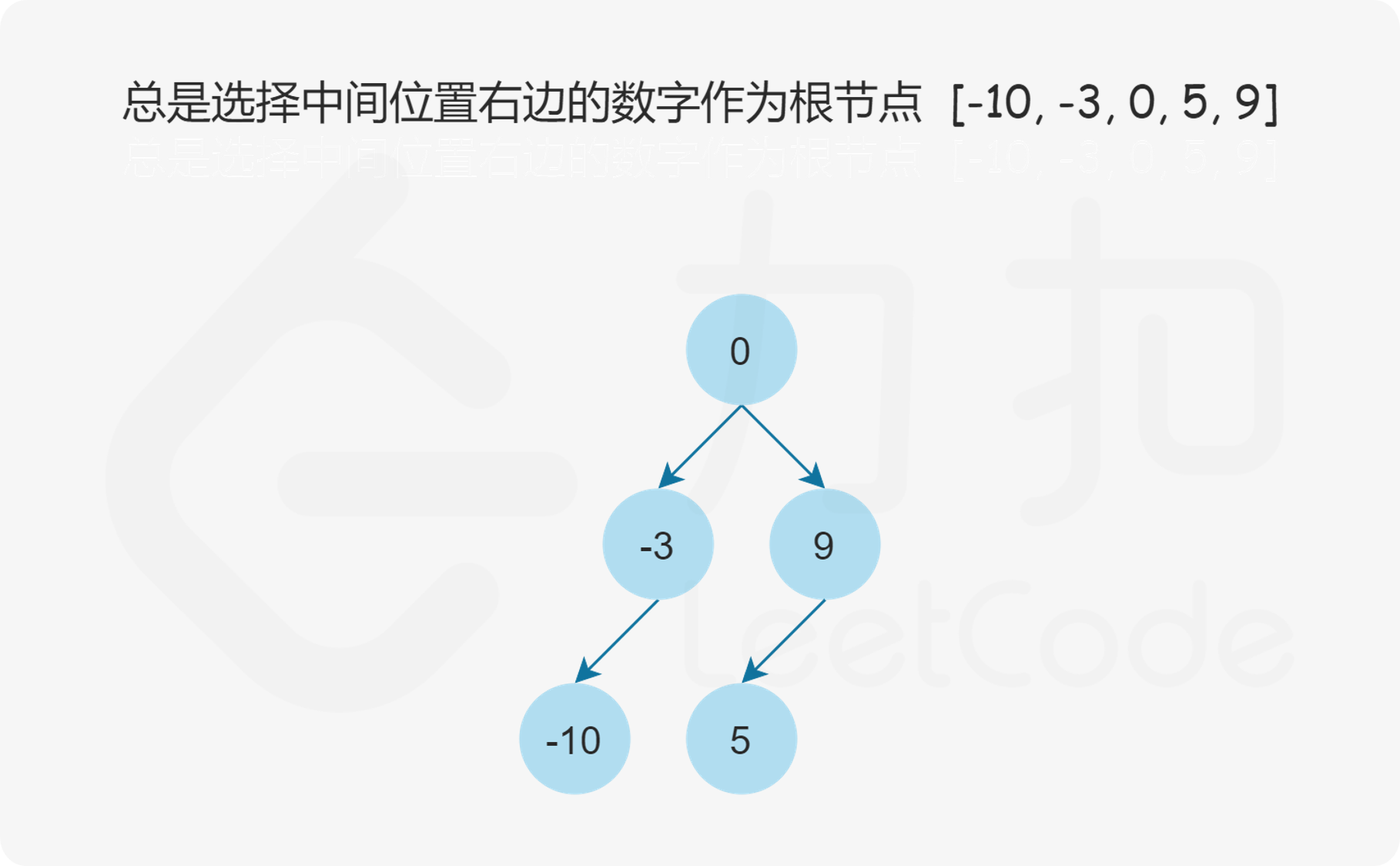
1 | /** |
时间复杂度:.
空间复杂度:.
43. 验证二叉搜索树
-
题面:
给你一个二叉树的根节点
root,判断其是否是一个有效的二叉搜索树。有效
二叉搜索树定义如下:-
节点的左子树只包含 小于 当前节点的数。
-
节点的右子树只包含 大于 当前节点的数。
-
所有左子树和右子树自身必须也是二叉搜索树。
-
-
示例1:
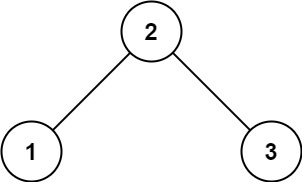
1
2输入:root = [2,1,3]
输出:true示例2:
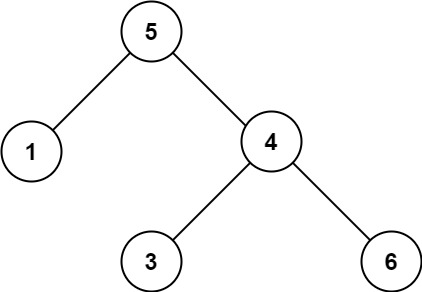
1
2
3输入:root = [5,1,4,null,null,3,6]
输出:false
解释:根节点的值是 5 ,但是右子节点的值是 4 。
自己想的,感觉通俗易懂。
1 | /** |
时间复杂度:.
空间复杂度:.
递归
1 | /** |
时间复杂度:.
空间复杂度:.
用栈实现的中序遍历,不如我想的方法,复杂度一样。
但是栈实现中序遍历的思想要学会。
1 | /** |
时间复杂度:.
空间复杂度:.
44. 二叉搜索树中第 K 小的元素
-
题面:
给定一个二叉搜索树的根节点
root,和一个整数k,请你设计一个算法查找其中第k小的元素(从 1 开始计数)。 -
示例 1:
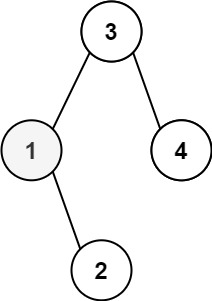
1
2输入:root = [3,1,4,null,2], k = 1
输出:1示例 2:
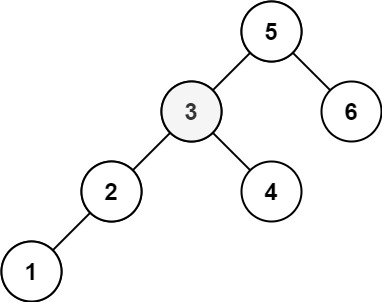
1
2输入:root = [5,3,6,2,4,null,null,1], k = 3
输出:3
1 | /** |
时间复杂度:.
空间复杂度:.
1 | /** |
时间复杂度:.
空间复杂度:.
45. 二叉树的右视图
-
题面:
给定一个二叉树的 根节点
root,想象自己站在它的右侧,按照从顶部到底部的顺序,返回从右侧所能看到的节点值。 -
示例:
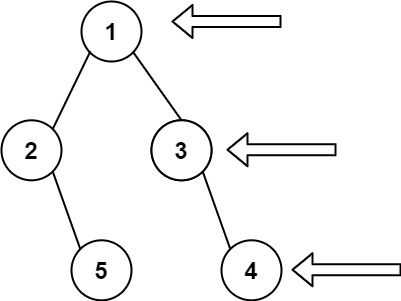
1
2输入: [1,2,3,null,5,null,4]
输出: [1,3,4]
1 | /** |
时间复杂度:.
空间复杂度:.
46. 二叉树展开为链表
-
题面:
给你二叉树的根结点
root,请你将它展开为一个单链表:-
展开后的单链表应该同样使用
TreeNode,其中right子指针指向链表中下一个结点,而左子指针始终为null。 -
展开后的单链表应该与二叉树
先序遍历顺序相同。
-
-
示例:
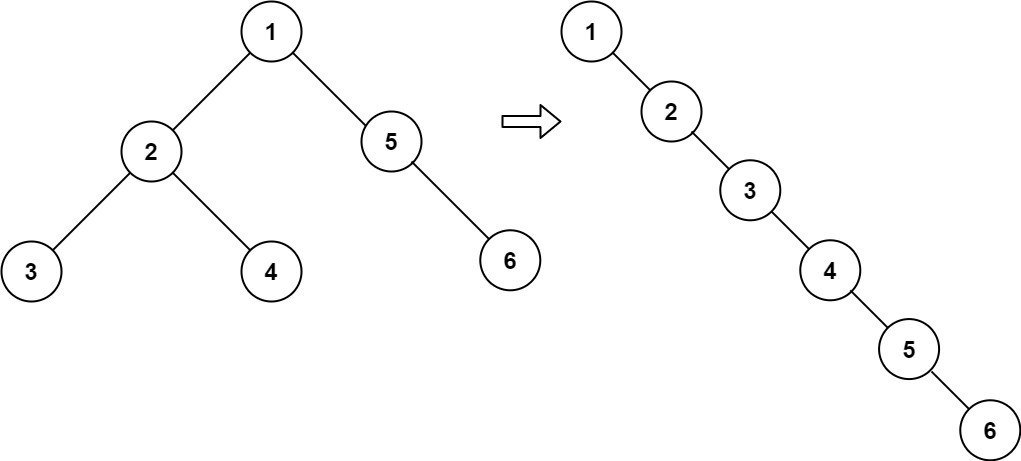
1
2输入:root = [1,2,5,3,4,null,6]
输出:[1,null,2,null,3,null,4,null,5,null,6]
1 | class Solution { |
时间复杂度:.
空间复杂度:.
1 | class Solution { |
时间复杂度:.
空间复杂度:.
1 | class Solution { |
时间复杂度:.
空间复杂度:.
1 | class Solution { |
时间复杂度:.
空间复杂度:.
47. 从前序与中序遍历序列构造二叉树
-
题面:
给定两个整数数组
preorder和inorder,其中preorder是二叉树的先序遍历,inorder是同一棵树的中序遍历,请构造二叉树并返回其根节点。preorder和inorder均 无重复 元素inorder均出现在preorderpreorder保证 为二叉树的前序遍历序列inorder保证 为二叉树的中序遍历序列
-
示例:
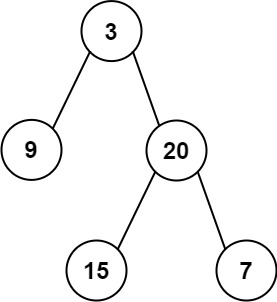
1
2输入: preorder = [3,9,20,15,7], inorder = [9,3,15,20,7]
输出: [3,9,20,null,null,15,7]
1 | /** |
时间复杂度:.
空间复杂度:.
1 | /** |
时间复杂度:.
空间复杂度:.
48. 路径总和 III
-
题面:
给定一个二叉树的根节点root,和一个整数targetSum,求该二叉树里节点值之和等于targetSum的路径的数目。路径不需要从根节点开始,也不需要在叶子节点结束,但是路径方向必须是向下的(只能从父节点到子节点)。 -
示例:
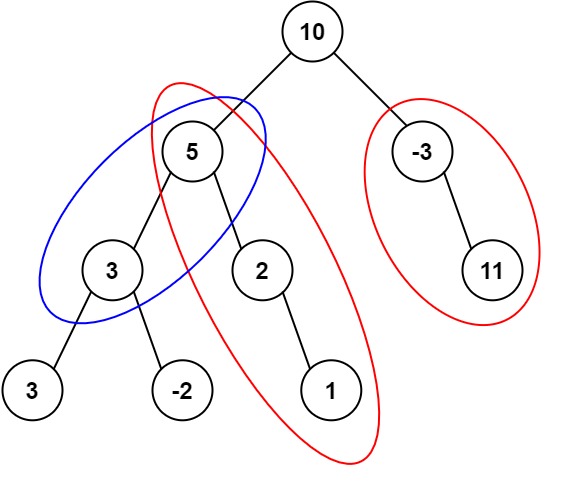
1
2
3输入:root = [10,5,-3,3,2,null,11,3,-2,null,1], targetSum = 8
输出:3
解释:和等于 8 的路径有 3 条,如图所示。
1 | /** |
时间复杂度:.
空间复杂度:.
借用哈希表,存储前面已经计算的结果。
每次借用前缀和出现的次数,来寻找本次能满足条件的数量。
1 | /** |
时间复杂度:.
空间复杂度:.
49. 二叉树的最近公共祖先
-
题面:
给定一个二叉树, 找到该树中两个指定节点的最近公共祖先。百度百科中最近公共祖先的定义为:“对于有根树 T 的两个节点 p、q,最近公共祖先表示为一个节点 x,满足 x 是 p、q 的祖先且 x 的深度尽可能大(一个节点也可以是它自己的祖先)。”
-
示例 1:
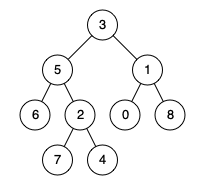
1
2
3输入:root = [3,5,1,6,2,0,8,null,null,7,4], p = 5, q = 1
输出:3
解释:节点 5 和节点 1 的最近公共祖先是节点 3 。示例 2:
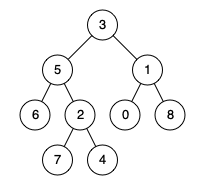
1
2
3输入:root = [3,5,1,6,2,0,8,null,null,7,4], p = 5, q = 4
输出:5
解释:节点 5 和节点 4 的最近公共祖先是节点 5 。因为根据定义最近公共祖先节点可以为节点本身。
1 | /** |
时间复杂度:.
空间复杂度:.
哈希表存储父节点。
1 | /** |
时间复杂度:.
空间复杂度:.
50. 二叉树中的最大路径和
-
题面:
二叉树中的
路径被定义为一条节点序列,序列中每对相邻节点之间都存在一条边。同一个节点在一条路径序列中 至多出现一次 。该路径 至少包含一个 节点,且不一定经过根节点。路径和是路径中各节点值的总和。给你一个二叉树的根节点
root,返回其最大路径和。 -
示例:
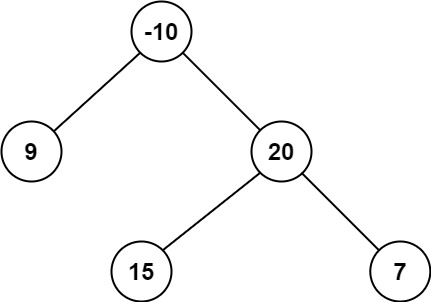
1
2
3输入:root = [-10,9,20,null,null,15,7]
输出:42
解释:最优路径是 15 -> 20 -> 7 ,路径和为 15 + 20 + 7 = 42
1 | /** |
时间复杂度:.
空间复杂度:.
八、图论
51. 岛屿数量
-
题面:
给你一个由'1'(陆地)和'0'(水)组成的的二维网格,请你计算网格中岛屿的数量。岛屿总是被水包围,并且每座岛屿只能由水平方向和/或竖直方向上相邻的陆地连接形成。
此外,你可以假设该网格的四条边均被水包围。
-
示例 1:
1
2
3
4
5
6
7输入:grid = [
["1","1","1","1","0"],
["1","1","0","1","0"],
["1","1","0","0","0"],
["0","0","0","0","0"]
]
输出:1示例 2:
1
2
3
4
5
6
7输入:grid = [
["1","1","0","0","0"],
["1","1","0","0","0"],
["0","0","1","0","0"],
["0","0","0","1","1"]
]
输出:3
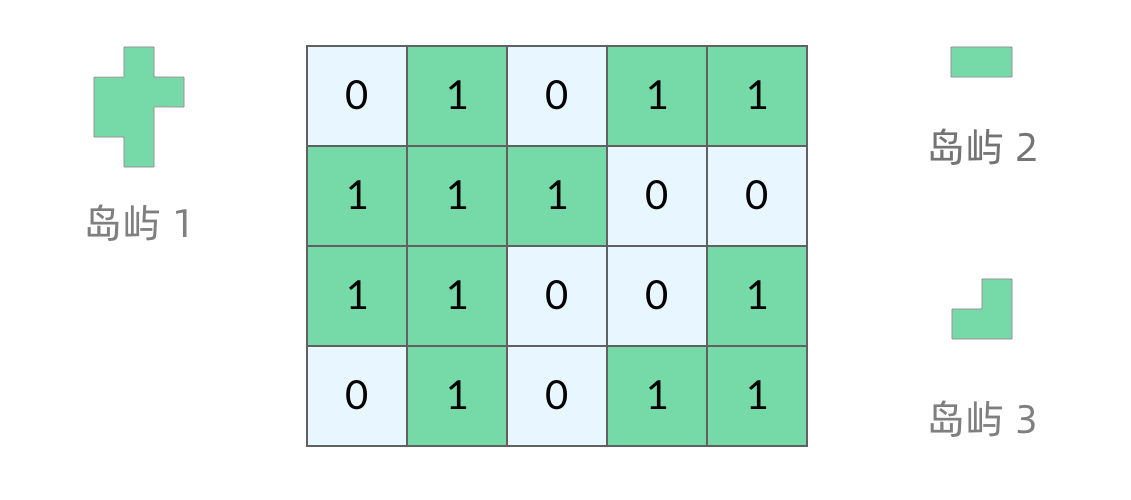
1 | class Solution { |
时间复杂度:.
空间复杂度:.
52. 腐烂的橘子
-
题面:
在给定的 m x n 网格 grid 中,每个单元格可以有以下三个值之一:值 0 代表空单元格;
值 1 代表新鲜橘子;
值 2 代表腐烂的橘子。
每分钟,腐烂的橘子 周围 4 个方向上相邻 的新鲜橘子都会腐烂。
返回 直到单元格中没有新鲜橘子为止所必须经过的最小分钟数。如果不可能,返回 -1 。
-
示例 1:
1
2输入:grid = [[2,1,1],[1,1,0],[0,1,1]]
输出:4 **示例 2:**
**示例 2:**
1
2输入:grid = [[2,1,1],[0,1,1],[1,0,1]]
输出:-1解释:左下角的橘子(第 2 行, 第 0 列)永远不会腐烂,因为腐烂只会发生在 4 个方向上。
示例 3:
1
2输入:grid = [[0,2]]
输出:0解释:因为 0 分钟时已经没有新鲜橘子了,所以答案就是 0 。
1 | class Solution { |
时间复杂度:.
空间复杂度:.
官方方法,使用了记录,要确保橘子数量不超过10*10大小
1 | class Solution { |
时间复杂度:.
空间复杂度:.
53. 课程表
-
题面:
你这个学期必须选修 numCourses 门课程,记为 0 到 numCourses - 1 。在选修某些课程之前需要一些先修课程。 先修课程按数组 prerequisites 给出,其中 prerequisites[i] = [ai, bi] ,表示如果要学习课程 ai 则 必须 先学习课程 bi 。
例如,先修课程对 [0, 1] 表示:想要学习课程 0 ,你需要先完成课程 1 。
请你判断是否可能完成所有课程的学习?如果可以,返回 true ;否则,返回 false 。
-
示例 1:
1
2输入:numCourses = 2, prerequisites = [[1,0]]
输出:true解释:总共有 2 门课程。学习课程 1 之前,你需要完成课程 0 。这是可能的。
示例 2:
1
2输入:numCourses = 2, prerequisites = [[1,0],[0,1]]
输出:false解释:总共有 2 门课程。学习课程 1 之前,你需要先完成课程 0 ;并且学习课程 0 之前,你还应先完成课程 1 。这是不可能的。
1 | class Solution { |
时间复杂度:.
空间复杂度:.
54. 实现 Trie (前缀树)
-
题面:
Trie(发音类似 “try”)或者说 前缀树 是一种树形数据结构,用于高效地存储和检索字符串数据集中的键。这一数据结构有相当多的应用情景,例如自动补全和拼写检查。请你实现 Trie 类:
Trie()初始化前缀树对象。void insert(String word)向前缀树中插入字符串word。boolean search(String word)如果字符串word在前缀树中,返回true(即,在检索之前已经插入);否则,返回false。boolean startsWith(String prefix)如果之前已经插入的字符串word的前缀之一为prefix,返回true;否则,返回false。
-
示例:
1
2
3
4
5
6
7
8
9
10
11
12
13输入
["Trie", "insert", "search", "search", "startsWith", "insert", "search"]
[[], ["apple"], ["apple"], ["app"], ["app"], ["app"], ["app"]]
输出
[null, null, true, false, true, null, true]
解释
Trie trie = new Trie();
trie.insert("apple");
trie.search("apple"); // 返回 True
trie.search("app"); // 返回 False
trie.startsWith("app"); // 返回 True
trie.insert("app");
trie.search("app"); // 返回 True
1 | class Trie { |
时间复杂度:.
空间复杂度:.
九、回溯
55. 全排列
-
题面:
给定一个不含重复数字的数组 nums ,返回其 所有可能的全排列 。你可以 按任意顺序 返回答案。 -
示例 1:
1
2输入:nums = [1,2,3]
输出:[[1,2,3],[1,3,2],[2,1,3],[2,3,1],[3,1,2],[3,2,1]]示例 2:
1
2输入:nums = [0,1]
输出:[[0,1],[1,0]]示例 3:
1
2输入:nums = [1]
输出:[[1]]
1 | class Solution { |
时间复杂度:.
空间复杂度:.
56. 子集
-
题面:
给你一个整数数组 nums ,数组中的元素互不相同。返回该数组所有可能的子集(幂集)。解集
不能包含重复的子集。你可以按 任意顺序 返回解集。 -
示例 1:
1
2输入:nums = [1,2,3]
输出:[[],[1],[2],[1,2],[3],[1,3],[2,3],[1,2,3]]示例 2:
1
2输入:nums = [0]
输出:[[],[0]]
1 | class Solution { |
时间复杂度:.
空间复杂度:.
1 | class Solution { |
时间复杂度:.
空间复杂度:.
57. 电话号码的字母组合
-
题面:
给定一个仅包含数字 2-9 的字符串,返回所有它能表示的字母组合。答案可以按 任意顺序 返回。给出数字到字母的映射如下(与电话按键相同)。注意 1 不对应任何字母。
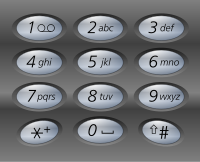
-
示例 1:
1
2输入:digits = "23"
输出:["ad","ae","af","bd","be","bf","cd","ce","cf"]示例 2:
1
2输入:digits = ""
输出:[]示例 3:
1
2输入:digits = "2"
输出:["a","b","c"]
1 | class Solution { |
时间复杂度:.
空间复杂度:.
58. 组合总和
-
题面:
给你一个 无重复元素 的整数数组candidates和一个目标整数target,找出candidates中可以使数字和为目标数target的 所有不同组合,并以列表形式返回。你可以按任意顺序返回这些组合。candidates中的同一个数字可以无限制重复被选取 。如果至少一个数字的被选数量不同,则两种组合是不同的。对于给定的输入,保证和为
target的不同组合数少于150个。 -
示例 1:
1
2
3
4
5
6输入:candidates = [2,3,6,7], target = 7
输出:[[2,2,3],[7]]
解释:
2 和 3 可以形成一组候选,2 + 2 + 3 = 7 。注意 2 可以使用多次。
7 也是一个候选, 7 = 7 。
仅有这两种组合。示例 2:
1
2输入: candidates = [2,3,5], target = 8
输出: [[2,2,2,2],[2,3,3],[3,5]]示例 3:
1
2输入: candidates = [2], target = 1
输出: []
1 | class Solution { |
时间复杂度:.
空间复杂度:.
1 | class Solution { |
时间复杂度:.
空间复杂度:.
59. 括号生成
-
题面:
数字 n 代表生成括号的对数,请你设计一个函数,用于能够生成所有可能的并且 有效的 括号组合。 -
示例 1:
1
2输入:n = 3
输出:["((()))","(()())","(())()","()(())","()()()"]示例 2:
1
2输入:n = 1
输出:["()"]
1 | class Solution { |
时间复杂度:.
空间复杂度:.
1 | class Solution { |
时间复杂度:.
空间复杂度:.
60. 单词搜索
-
题面:
给定一个m x n二维字符网格board和一个字符串单词word。如果word存在于网格中,返回true;否则,返回false。单词必须按照字母顺序,通过相邻的单元格内的字母构成,其中“相邻”单元格是那些水平相邻或垂直相邻的单元格。同一个单元格内的字母不允许被重复使用。
board和word仅由大小写英文字母组成 -
示例 1:
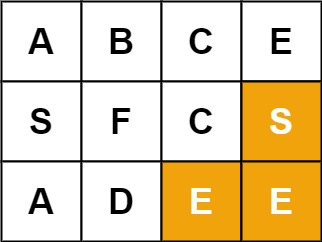
1
2输入:board = [["A","B","C","E"],["S","F","C","S"],["A","D","E","E"]], word = "ABCCED"
输出:true示例 2:
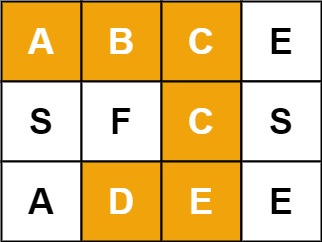
1
2输入:board = [["A","B","C","E"],["S","F","C","S"],["A","D","E","E"]], word = "SEE"
输出:true示例 3:
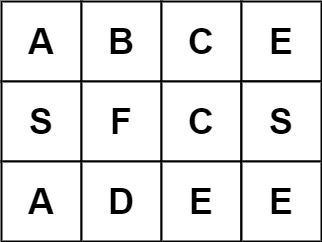
1
2输入:board = [["A","B","C","E"],["S","F","C","S"],["A","D","E","E"]], word = "ABCB"
输出:false
1 | class Solution { |
时间复杂度:.
空间复杂度:.
61. 分割回文串
-
题面:
给你一个字符串s,请你将s分割成一些子串,使每个子串都是回文串。返回s所有可能的分割方案。s仅由小写英文字母组成 -
示例 1:
1
2输入:s = "aab"
输出:[["a","a","b"],["aa","b"]]示例 2:
1
2输入:s = "a"
输出:[["a"]]
1 | class Solution { |
时间复杂度:.
空间复杂度:.
62. N 皇后
-
题面:
按照国际象棋的规则,皇后可以攻击与之处在同一行或同一列或同一斜线上的棋子。n 皇后问题 研究的是如何将 n 个皇后放置在
n×n的棋盘上,并且使皇后彼此之间不能相互攻击。给你一个整数
n,返回所有不同的 n 皇后问题 的解决方案。每一种解法包含一个不同的 n 皇后问题 的棋子放置方案,该方案中
'Q'和'.'分别代表了皇后和空位。 -
示例 1:
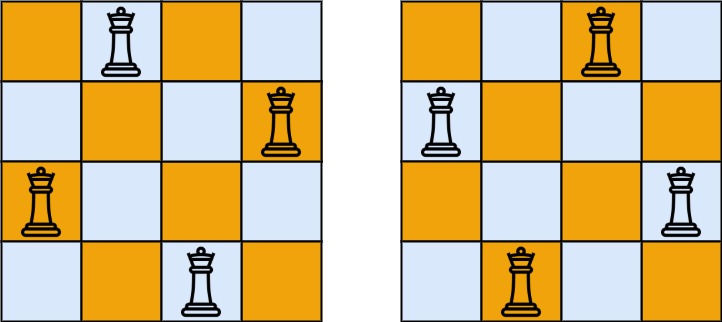
1
2
3输入:n = 4
输出:[[".Q..","...Q","Q...","..Q."],["..Q.","Q...","...Q",".Q.."]]
解释:如上图所示,4 皇后问题存在两个不同的解法。示例 2:
1
2输入:n = 1
输出:[["Q"]]
1 | class Solution { |
时间复杂度:.
空间复杂度:.
十、二分查找
63. 搜索插入位置
-
题面:
给定一个排序数组和一个目标值,在数组中找到目标值,并返回其索引。如果目标值不存在于数组中,返回它将会被按顺序插入的位置。请必须使用时间复杂度为
O(log n)的算法。nums为无重复元素的升序排列数组。 -
示例 1:
1
2输入: nums = [1,3,5,6], target = 5
输出: 2示例 2:
1
2输入: nums = [1,3,5,6], target = 2
输出: 1示例 3:
1
2输入: nums = [1,3,5,6], target = 7
输出: 4
1 | class Solution { |
时间复杂度:.
空间复杂度:.
64. 搜索二维矩阵
-
题面:
给你一个满足下述两条属性的m x n整数矩阵:每行中的整数从左到右按非严格递增顺序排列。
每行的第一个整数大于前一行的最后一个整数。
给你一个整数
target,如果target在矩阵中,返回true;否则,返回false。 -
示例 1:
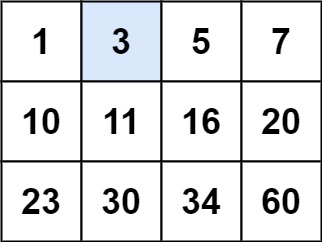
1
2输入:matrix = [[1,3,5,7],[10,11,16,20],[23,30,34,60]], target = 3
输出:true示例 2:
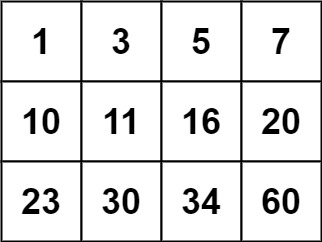
1
2输入:matrix = [[1,3,5,7],[10,11,16,20],[23,30,34,60]], target = 13
输出:false
1 | class Solution { |
时间复杂度:.
空间复杂度:.
1 | class Solution { |
时间复杂度:.
空间复杂度:.
1 | class Solution { |
时间复杂度:.
空间复杂度:.
65. 在排序数组中查找元素的第一个和最后一个位置
-
题面:
给你一个按照非递减顺序排列的整数数组nums,和一个目标值target。请你找出给定目标值在数组中的开始位置和结束位置。如果数组中不存在目标值
target,返回[-1, -1]。你必须设计并实现时间复杂度为
O(log n)的算法解决此问题。 -
示例 1:
1
2输入:nums = [5,7,7,8,8,10], target = 8
输出:[3,4]示例 2:
1
2输入:nums = [5,7,7,8,8,10], target = 6
输出:[-1,-1]示例 3:
1
2输入:nums = [], target = 0
输出:[-1,-1]
1 | class Solution { |
时间复杂度:.
空间复杂度:.
1 | class Solution { |
时间复杂度:.
空间复杂度:.
66. 搜索旋转排序数组
-
题面:
整数数组nums按升序排列,数组中的值 互不相同 。在传递给函数之前,
nums在预先未知的某个下标k(0 <= k < nums.length)上进行了 旋转,使数组变为[nums[k], nums[k+1], ..., nums[n-1], nums[0], nums[1], ..., nums[k-1]](下标 从 0 开始 计数)。例如,[0,1,2,4,5,6,7]在下标3处经旋转后可能变为[4,5,6,7,0,1,2]。给你 旋转后 的数组
nums和一个整数target,如果nums中存在这个目标值target,则返回它的下标,否则返回-1。你必须设计一个时间复杂度为
O(log n)的算法解决此问题。 -
示例 1:
1
2输入:nums = [4,5,6,7,0,1,2], target = 0
输出:4示例 2:
1
2输入:nums = [4,5,6,7,0,1,2], target = 3
输出:-1示例 3:
1
2输入:nums = [1], target = 0
输出:-1
1 | class Solution { |
时间复杂度:.
空间复杂度:.
67. 寻找旋转排序数组中的最小值
-
题面:
已知一个长度为n的数组,预先按照升序排列,经由 1 到 n 次 旋转 后,得到输入数组。例如,原数组nums = [0,1,2,4,5,6,7]在变化后可能得到:若旋转
4次,则可以得到[4,5,6,7,0,1,2]若旋转
7次,则可以得到[0,1,2,4,5,6,7]注意,数组
[a[0], a[1], a[2], ..., a[n-1]]旋转一次 的结果为数组[a[n-1], a[0], a[1], a[2], ..., a[n-2]]。给你一个元素值 互不相同 的数组
nums,它原来是一个升序排列的数组,并按上述情形进行了多次旋转。请你找出并返回数组中的 最小元素 。你必须设计一个时间复杂度为
O(log n)的算法解决此问题。 -
示例 1:
1
2
3输入:nums = [3,4,5,1,2]
输出:1
解释:原数组为 [1,2,3,4,5] ,旋转 3 次得到输入数组。示例 2:
1
2
3输入:nums = [4,5,6,7,0,1,2]
输出:0
解释:原数组为 [0,1,2,4,5,6,7] ,旋转 4 次得到输入数组。示例 3:
1
2
3输入:nums = [11,13,15,17]
输出:11
解释:原数组为 [11,13,15,17] ,旋转 4 次得到输入数组。
1 | class Solution { |
时间复杂度:.
空间复杂度:.
1 | class Solution { |
时间复杂度:.
空间复杂度:.
1 | class Solution { |
时间复杂度:.
空间复杂度:.
68. 寻找两个正序数组的中位数
-
题面:
给定两个大小分别为m和n的正序(从小到大)数组nums1和nums2。请你找出并返回这两个正序数组的 中位数 。算法的时间复杂度应该为
O(log (m+n))。 -
示例 1:
1
2
3输入:nums1 = [1,3], nums2 = [2]
输出:2.00000
解释:合并数组 = [1,2,3] ,中位数 2示例 2:
1
2
3输入:nums1 = [1,2], nums2 = [3,4]
输出:2.50000
解释:合并数组 = [1,2,3,4] ,中位数 (2 + 3) / 2 = 2.5
1 | class Solution { |
时间复杂度:.
空间复杂度:.
1 | class Solution { |
时间复杂度:.
空间复杂度:.
1 | class Solution { |
时间复杂度:.
空间复杂度:.
十一、栈
69. 有效的括号
-
题面:
给定一个只包括'(',')','{','}','[',']'的字符串s,判断字符串是否有效。有效字符串需满足:
-
左括号必须用相同类型的右括号闭合。
-
左括号必须以正确的顺序闭合。
-
每个右括号都有一个对应的相同类型的左括号。
-
-
示例 1:
1
2输入:s = "()"
输出:true示例 2:
1
2输入:s = "()[]{}"
输出:true示例 3:
1
2输入:s = "(]"
输出:false示例 4:
1
2输入:s = "([])"
输出:true
1 | class Solution { |
时间复杂度:.
空间复杂度:.
1 | class Solution { |
时间复杂度:.
空间复杂度:.
70. 最小栈
-
题面:
设计一个支持push,pop,top操作,并能在常数时间内检索到最小元素的栈。实现
MinStack类:MinStack()初始化堆栈对象。void push(int val)将元素val推入堆栈。void pop()删除堆栈顶部的元素。int top()获取堆栈顶部的元素。int getMin()获取堆栈中的最小元素。
pop、top和getMin操作总是在 非空栈 上调用 -
示例 1:
1
2
3
4
5
6
7
8
9
10
11
12
13
14
15输入:
["MinStack","push","push","push","getMin","pop","top","getMin"]
[[],[-2],[0],[-3],[],[],[],[]]
输出:
[null,null,null,null,-3,null,0,-2]
解释:
MinStack minStack = new MinStack();
minStack.push(-2);
minStack.push(0);
minStack.push(-3);
minStack.getMin(); --> 返回 -3.
minStack.pop();
minStack.top(); --> 返回 0.
minStack.getMin(); --> 返回 -2.
1 | class MinStack { |
时间复杂度:.
空间复杂度:.
71. 字符串解码
-
题面:
给定一个经过编码的字符串,返回它解码后的字符串。编码规则为:
k[encoded_string],表示其中方括号内部的encoded_string正好重复k次。注意k保证为正整数。你可以认为输入字符串总是有效的;输入字符串中没有额外的空格,且输入的方括号总是符合格式要求的。
此外,你可以认为原始数据不包含数字,所有的数字只表示重复的次数
k,例如不会出现像3a或2[4]的输入。s由小写英文字母、数字和方括号 '[]'组成s保证是一个 有效 的输入。s中所有整数的取值范围为[1, 300]
-
示例 1:
1
2输入:s = "3[a]2[bc]"
输出:"aaabcbc"示例 2:
1
2输入:s = "3[a2[c]]"
输出:"accaccacc"示例 3:
1
2输入:s = "2[abc]3[cd]ef"
输出:"abcabccdcdcdef"示例 4:
1
2输入:s = "abc3[cd]xyz"
输出:"abccdcdcdxyz"
1 | class Solution { |
时间复杂度:.
空间复杂度:.
1 | class Solution { |
时间复杂度:.
空间复杂度:.
72. 每日温度
-
题面:
给定一个整数数组temperatures,表示每天的温度,返回一个数组answer,其中answer[i]是指对于第i天,下一个更高温度出现在几天后。如果气温在这之后都不会升高,请在该位置用0来代替。提示:
- 1 <=
temperatures.length<= 105 - 30 <=
temperatures[i]<= 100
- 1 <=
-
示例 1:
1
2输入: temperatures = [73,74,75,71,69,72,76,73]
输出: [1,1,4,2,1,1,0,0]示例 2:
1
2输入: temperatures = [30,40,50,60]
输出: [1,1,1,0]示例 3:
1
2输入: temperatures = [30,60,90]
输出: [1,1,0]
1 | class Solution { |
时间复杂度:.
空间复杂度:.
1 | class Solution { |
时间复杂度:.
空间复杂度:.
1 | class Solution { |
时间复杂度:.
空间复杂度:.
73. 柱状图中最大的矩形
-
题面:
给定n个非负整数,用来表示柱状图中各个柱子的高度。每个柱子彼此相邻,且宽度为1。求在该柱状图中,能够勾勒出来的矩形的最大面积。
-
示例 1:

1
2
3输入:heights = [2,1,5,6,2,3]
输出:10
解释:最大的矩形为图中红色区域,面积为 10示例 2:
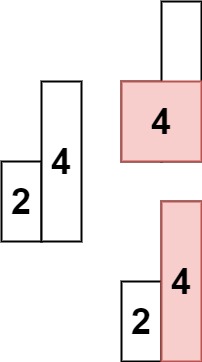
1
2输入: heights = [2,4]
输出: 4
1 | class Solution { |
时间复杂度:.
空间复杂度:.
1 | class Solution { |
时间复杂度:.
空间复杂度:.
1 | class Solution { |
时间复杂度:.
空间复杂度:.
十二、堆
74. 数组中的第K个最大元素
-
题面:
给定整数数组nums和整数k,请返回数组中第k个最大的元素。请注意,你需要找的是数组排序后的第
k个最大的元素,而不是第k个不同的元素。你必须设计并实现时间复杂度为
O(n)的算法解决此问题。 -
示例 1:
1
2输入: [3,2,1,5,6,4], k = 2
输出: 5示例 2:
1
2输入: [3,2,3,1,2,4,5,5,6], k = 4
输出: 4
1 | class Solution { |
时间复杂度:.
空间复杂度:.
1 | class Solution { |
时间复杂度:.
空间复杂度:.
1 | // 正确做法:需要自己实现大根堆(递归实现,利用完全二叉树的性质) |
时间复杂度:.
空间复杂度:.
75. 前 K 个高频元素
-
题面:
给你一个整数数组nums和一个整数k,请你返回其中出现频率前k高的元素。你可以按任意顺序返回答案。提示:
- 1 <=
nums.length<= 105 k的取值范围是[1, 数组中不相同的元素的个数]- 题目数据保证答案唯一,换句话说,数组中前
k个高频元素的集合是唯一的
**进阶:**你所设计算法的时间复杂度 必须 优于
O(n log n),其中n是数组大小。 - 1 <=
-
示例 1:
1
2输入: nums = [1,1,1,2,2,3], k = 2
输出: [1,2]示例 2:
1
2输入: nums = [1], k = 1
输出: [1]
1 | class Solution { |
时间复杂度:.
空间复杂度:.
1 | class Solution { |
时间复杂度:.
空间复杂度:.
1 | class Solution { |
时间复杂度:.
空间复杂度:.
76. 数据流的中位数
-
题面:
中位数是有序整数列表中的中间值。如果列表的大小是偶数,则没有中间值,中位数是两个中间值的平均值。例如
arr = [2,3,4]的中位数是3。例如
arr = [2,3]的中位数是(2 + 3) / 2 = 2.5。实现
MedianFinder类:MedianFinder()初始化MedianFinder对象。void addNum(int num)将数据流中的整数num添加到数据结构中。double findMedian()返回到目前为止所有元素的中位数。与实际答案相差10^{-5}以内的答案将被接受。提示:
-105 <= num <= 105- 在调用
findMedian之前,数据结构中至少有一个元素 - 最多
5 * 104次调用addNum和findMedian
-
示例 1:
1
2
3
4
5
6
7
8
9
10
11
12
13输入
["MedianFinder", "addNum", "addNum", "findMedian", "addNum", "findMedian"]
[[], [1], [2], [], [3], []]
输出
[null, null, null, 1.5, null, 2.0]
解释
MedianFinder medianFinder = new MedianFinder();
medianFinder.addNum(1); // arr = [1]
medianFinder.addNum(2); // arr = [1, 2]
medianFinder.findMedian(); // 返回 1.5 ((1 + 2) / 2)
medianFinder.addNum(3); // arr[1, 2, 3]
medianFinder.findMedian(); // return 2.0
1 | // 超出时间限制 |
时间复杂度:.
空间复杂度:.
1 | class MedianFinder { |
时间复杂度:.
空间复杂度:.
十三、贪心算法
77. 买卖股票的最佳时机
-
题面:
给定一个数组prices,它的第i个元素prices[i]表示一支给定股票第i天的价格。你只能选择 某一天 买入这只股票,并选择在 未来的某一个不同的日子 卖出该股票。设计一个算法来计算你所能获取的最大利润。
返回你可以从这笔交易中获取的最大利润。如果你不能获取任何利润,返回
0。 -
示例 1:
1
2
3
4输入:[7,1,5,3,6,4]
输出:5
解释:在第 2 天(股票价格 = 1)的时候买入,在第 5 天(股票价格 = 6)的时候卖出,最大利润 = 6-1 = 5 。
注意利润不能是 7-1 = 6, 因为卖出价格需要大于买入价格;同时,你不能在买入前卖出股票。示例 2:
1
2
3输入:prices = [7,6,4,3,1]
输出:0
解释:在这种情况下, 没有交易完成, 所以最大利润为 0。
1 | class Solution { |
时间复杂度:.
空间复杂度:.
78. 跳跃游戏
-
题面:
给你一个非负整数数组nums,你最初位于数组的 第一个下标 。数组中的每个元素代表你在该位置可以跳跃的最大长度。判断你是否能够到达最后一个下标,如果可以,返回
true;否则,返回false。 -
示例 1:
1
2
3输入:nums = [2,3,1,1,4]
输出:true
解释:可以先跳 1 步,从下标 0 到达下标 1, 然后再从下标 1 跳 3 步到达最后一个下标。示例 2:
1
2
3输入:nums = [3,2,1,0,4]
输出:false
解释:无论怎样,总会到达下标为 3 的位置。但该下标的最大跳跃长度是 0 , 所以永远不可能到达最后一个下标。
1 | class Solution { |
时间复杂度:.
空间复杂度:.
79. 跳跃游戏 II
-
题面:
给定一个长度为n的0索引整数数组nums。初始位置为nums[0]。每个元素
nums[i]表示从索引i向后跳转的最大长度。换句话说,如果你在nums[i]处,你可以跳转到任意nums[i + j]处:0 <= j <= nums[i]i + j < n
返回到达
nums[n - 1]的最小跳跃次数。生成的测试用例可以到达
nums[n - 1]。提示:
1 <= nums.length <= 1040 <= nums[i] <= 1000题目保证可以到达 nums[n-1]
-
示例 1:
1
2
3
4输入: nums = [2,3,1,1,4]
输出: 2
解释: 跳到最后一个位置的最小跳跃数是 2。
从下标为 0 跳到下标为 1 的位置,跳 1 步,然后跳 3 步到达数组的最后一个位置。示例 2:
1
2输入: nums = [2,3,0,1,4]
输出: 2
1 | class Solution { |
时间复杂度:.
空间复杂度:.
1 | class Solution { |
时间复杂度:.
空间复杂度:.
1 | class Solution { |
时间复杂度:.
空间复杂度:.
80. 划分字母区间
-
题面:
给你一个字符串s。我们要把这个字符串划分为尽可能多的片段,同一字母最多出现在一个片段中。例如,字符串"ababcc"能够被分为["abab", "cc"],但类似["aba", "bcc"]或["ab", "ab", "cc"]的划分是非法的。注意,划分结果需要满足:将所有划分结果按顺序连接,得到的字符串仍然是
s。返回一个表示每个字符串片段的长度的列表。
提示:
1 <= s.length <= 500s仅由小写英文字母组成
-
示例 1:
1
2
3
4
5
6输入:s = "ababcbacadefegdehijhklij"
输出:[9,7,8]
解释:
划分结果为 "ababcbaca"、"defegde"、"hijhklij" 。
每个字母最多出现在一个片段中。
像 "ababcbacadefegde", "hijhklij" 这样的划分是错误的,因为划分的片段数较少。示例 2:
1
2输入:s = "eccbbbbdec"
输出:[10]
1 | class Solution { |
时间复杂度:.
空间复杂度:.
1 | class Solution { |
时间复杂度:.
空间复杂度:.
十四、动态规划
81. 爬楼梯
-
题面:
假设你正在爬楼梯。需要n阶你才能到达楼顶。每次你可以爬
1或2个台阶。你有多少种不同的方法可以爬到楼顶呢?提示:
1 <= n <= 45
-
示例 1:
1
2
3
4
5输入:n = 2
输出:2
解释:有两种方法可以爬到楼顶。
1. 1 阶 + 1 阶
2. 2 阶示例 2:
1
2
3
4
5
6输入:n = 3
输出:3
解释:有三种方法可以爬到楼顶。
1. 1 阶 + 1 阶 + 1 阶
2. 1 阶 + 2 阶
3. 2 阶 + 1 阶
1 | class Solution { |
时间复杂度:.
空间复杂度:.
1 | class Solution { |
时间复杂度:.
空间复杂度:.
这里找到递推公式的矩阵乘法运算,使用快速矩阵幂运算,进行一次运算即可。
时间复杂度降到快速幂运算的时间复杂度 。
不强求会代码,但是思路很好,可以参考链接:方法二
1 | class Solution { |
时间复杂度:.
空间复杂度:.
82. 杨辉三角
-
题面:
给定一个非负整数numRows,生成「杨辉三角」的前numRows行。在
「杨辉三角」中,每个数是它左上方和右上方的数的和。提示:
1 <= numRows <= 30
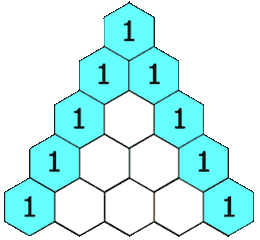
-
示例 1:
1
2输入: numRows = 5
输出: [[1],[1,1],[1,2,1],[1,3,3,1],[1,4,6,4,1]]示例 2:
1
2输入: numRows = 1
输出: [[1]]
1 | class Solution { |
时间复杂度:.
空间复杂度:.
83. 打家劫舍
-
题面:
你是一个专业的小偷,计划偷窃沿街的房屋。每间房内都藏有一定的现金,影响你偷窃的唯一制约因素就是相邻的房屋装有相互连通的防盗系统,如果两间相邻的房屋在同一晚上被小偷闯入,系统会自动报警。给定一个代表每个房屋存放金额的非负整数数组,计算你 不触动警报装置的情况下 ,一夜之内能够偷窃到的最高金额。
提示:
1 <= nums.length <= 1000 <= nums[i] <= 400
-
示例 1:
1
2
3
4输入:[1,2,3,1]
输出:4
解释:偷窃 1 号房屋 (金额 = 1) ,然后偷窃 3 号房屋 (金额 = 3)。
偷窃到的最高金额 = 1 + 3 = 4 。示例 2:
1
2
3
4输入:[2,7,9,3,1]
输出:12
解释:偷窃 1 号房屋 (金额 = 2), 偷窃 3 号房屋 (金额 = 9),接着偷窃 5 号房屋 (金额 = 1)。
偷窃到的最高金额 = 2 + 9 + 1 = 12 。
1 | class Solution { |
时间复杂度:.
空间复杂度:.
84. 完全平方数
-
题面:
给你一个整数n,返回 和为n的完全平方数的最少数量 。完全平方数 是一个整数,其值等于另一个整数的平方;换句话说,其值等于一个整数自乘的积。例如,
1、4、9 和 16都是完全平方数,而3和11不是。提示:
1 <= n <= 104
-
示例 1:
1
2
3输入:n = 12
输出:3
解释:12 = 4 + 4 + 4示例 2:
1
2
3输入:n = 13
输出:2
解释:13 = 4 + 9
1 | class Solution { |
时间复杂度:.
空间复杂度:.
1 | class Solution { |
时间复杂度:.
空间复杂度:.
85. 零钱兑换
-
题面:
给你一个整数数组coins,表示不同面额的硬币;以及一个整数amount,表示总金额。计算并返回可以凑成总金额所需的 最少的硬币个数 。如果没有任何一种硬币组合能组成总金额,返回
-1。你可以认为每种硬币的数量是无限的。
-
示例 1:
1
2
3输入:coins = [1, 2, 5], amount = 11
输出:3
解释:11 = 5 + 5 + 1示例 2:
1
2输入:coins = [2], amount = 3
输出:-1示例 3:
1
2输入:coins = [1], amount = 0
输出:0
1 | class Solution { |
时间复杂度:.
空间复杂度:.
1 | class Solution { |
时间复杂度:.
空间复杂度:.
86. 单词拆分
-
题面:
给你一个字符串s和一个字符串列表wordDict作为字典。如果可以利用字典中出现的一个或多个单词拼接出s则返回true。注意:不要求字典中出现的单词全部都使用,并且字典中的单词可以重复使用。
提示:
1 <= s.length <= 3001 <= wordDict.length <= 10001 <= wordDict[i].length <= 20s和wordDict[i]仅由小写英文字母组成wordDict中的所有字符串 互不相同
-
示例 1:
1
2
3输入: s = "leetcode", wordDict = ["leet", "code"]
输出: true
解释: 返回 true 因为 "leetcode" 可以由 "leet" 和 "code" 拼接成。示例 2:
1
2
3
4输入: s = "applepenapple", wordDict = ["apple", "pen"]
输出: true
解释: 返回 true 因为 "applepenapple" 可以由 "apple" "pen" "apple" 拼接成。
注意,你可以重复使用字典中的单词。示例 3:
1
2输入: s = "catsandog", wordDict = ["cats", "dog", "sand", "and", "cat"]
输出: false
1 | class Solution { |
时间复杂度:.
空间复杂度:.
87. 最长递增子序列
-
题面:
给你一个整数数组nums,找到其中最长严格递增子序列的长度。子序列 是由数组派生而来的序列,删除(或不删除)数组中的元素而不改变其余元素的顺序。例如,
[3,6,2,7]是数组[0,3,1,6,2,2,7]的子序列。提示:
1 <= nums.length <= 2500-104 <= nums[i] <= 104
进阶:
- 你能将算法的时间复杂度降低到 吗?
-
示例 1:
1
2
3输入:nums = [10,9,2,5,3,7,101,18]
输出:4
解释:最长递增子序列是 [2,3,7,101],因此长度为 4 。示例 2:
1
2输入:nums = [0,1,0,3,2,3]
输出:4示例 3:
1
2输入:nums = [7,7,7,7,7,7,7]
输出:1
1 | // 不能直接使用单调栈,单调栈是保证最后一个元素一定入栈 |
时间复杂度:.
空间复杂度:.
若看不懂,请参考:深度解析
1 | class Solution { |
时间复杂度:.
空间复杂度:.
88. 乘积最大子数组
-
题面:
给你一个整数数组nums,请你找出数组中乘积最大的非空连续 子数组(该子数组中至少包含一个数字),并返回该子数组所对应的乘积。测试用例的答案是一个
32-位整数。提示:
1 <= nums.length <= 2 * 104-10 <= nums[i] <= 10nums的任何子数组的乘积都 保证 是一个32-位整数
-
示例 1:
1
2
3输入: nums = [2,3,-2,4]
输出: 6
解释: 子数组 [2,3] 有最大乘积 6。示例 2:
1
2
3输入: nums = [-2,0,-1]
输出: 0
解释: 结果不能为 2, 因为 [-2,-1] 不是子数组。
1 | class Solution { |
时间复杂度:.
空间复杂度:.
1 | class Solution { |
时间复杂度:.
空间复杂度:.
89. 分割等和子集
-
题面:
给你一个 只包含正整数 的 非空 数组nums。请你判断是否可以将这个数组分割成两个子集,使得两个子集的元素和相等。提示:
1 <= nums.length <= 2001 <= nums[i] <= 100
-
示例 1:
1
2
3输入:nums = [1,5,11,5]
输出:true
解释:数组可以分割成 [1, 5, 5] 和 [11] 。示例 2:
1
2
3输入:nums = [1,2,3,5]
输出:false
解释:数组不能分割成两个元素和相等的子集。
1 | class Solution { |
时间复杂度:.
空间复杂度:.
1 | class Solution { |
时间复杂度:.
空间复杂度:.
90. 最长有效括号
-
题面:
给你一个只包含'('和')'的字符串,找出最长有效(格式正确且连续)括号子串的长度。提示:
0 <= s.length <= 3 * 104s[i]为'('或')'
-
示例 1:
1
2
3输入:s = "(()"
输出:2
解释:最长有效括号子串是 "()"示例 2:
1
2
3输入:s = ")()())"
输出:4
解释:最长有效括号子串是 "()()"示例 3:
1
2输入:s = ""
输出:0
1 | class Solution { |
时间复杂度:.
空间复杂度:.
1 | class Solution { |
时间复杂度:.
空间复杂度:.
十五、多维动态规划
91. 不同路径
-
题面:
一个机器人位于一个m x n网格的左上角 (起始点在下图中标记为“Start”)。机器人每次只能向下或者向右移动一步。机器人试图达到网格的右下角(在下图中标记为
“Finish”)。问总共有多少条不同的路径?
提示:
1 <= m, n <= 100- 题目数据保证答案小于等于
2 * 109
-
示例 1:
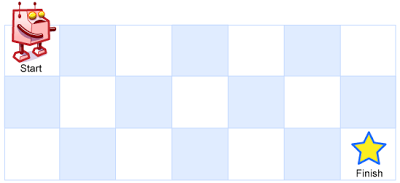
1
2输入:m = 3, n = 7
输出:28示例 2:
1
2
3
4
5
6
7输入:m = 3, n = 2
输出:3
解释:
从左上角开始,总共有 3 条路径可以到达右下角。
1. 向右 -> 向下 -> 向下
2. 向下 -> 向下 -> 向右
3. 向下 -> 向右 -> 向下示例 3:
1
2输入:m = 7, n = 3
输出:28示例 4:
1
2输入:m = 3, n = 3
输出:6
1 | class Solution { |
时间复杂度:.
空间复杂度:.
1 | class Solution { |
时间复杂度:.
空间复杂度:.
92. 最小路径和
-
题面:
给定一个包含非负整数的m x n网格grid,请找出一条从左上角到右下角的路径,使得路径上的数字总和为最小。说明:每次只能向下或者向右移动一步。
-
示例 1:
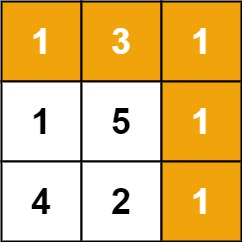
1
2
3输入:grid = [[1,3,1],[1,5,1],[4,2,1]]
输出:7
解释:因为路径 1→3→1→1→1 的总和最小。示例 2:
1
2输入:grid = [[1,2,3],[4,5,6]]
输出:12
1 | class Solution { |
时间复杂度:.
空间复杂度:.
93. 最长回文子串
-
题面:
给你一个字符串s,找到s中最长的 回文 子串。提示:
1 <= s.length <= 1000s仅由数字和英文字母组成
-
示例 1:
1
2
3输入:s = "babad"
输出:"bab"
解释:"aba" 同样是符合题意的答案。示例 2:
1
2输入:s = "cbbd"
输出:"bb"
1 | class Solution { |
时间复杂度:.
空间复杂度:.
中心扩展法,时间复杂度不变,但是空间占用小。
参考链接
1 | class Solution { |
时间复杂度:.
空间复杂度:.
94. 最长公共子序列
-
题面:
给定两个字符串text1和text2,返回这两个字符串的最长 公共子序列 的长度。如果不存在 公共子序列 ,返回0。一个字符串的 子序列 是指这样一个新的字符串:它是由原字符串在不改变字符的相对顺序的情况下删除某些字符(也可以不删除任何字符)后组成的新字符串。
例如,
"ace"是"abcde"的子序列,但"aec"不是"abcde"的子序列。两个字符串的 公共子序列 是这两个字符串所共同拥有的子序列。
提示:
1 <= text1.length, text2.length <= 1000text1和text2仅由小写英文字符组成。
-
示例 1:
1
2
3输入:text1 = "abcde", text2 = "ace"
输出:3
解释:最长公共子序列是 "ace" ,它的长度为 3 。示例 2:
1
2
3输入:text1 = "abc", text2 = "abc"
输出:3
解释:最长公共子序列是 "abc" ,它的长度为 3 。示例 3:
1
2
3输入:text1 = "abc", text2 = "def"
输出:0
解释:两个字符串没有公共子序列,返回 0 。
1 | class Solution { |
时间复杂度:.
空间复杂度:.
95. 编辑距离
-
题面:
给你两个单词word1和word2, 请返回将word1转换成word2所使用的最少操作数 。你可以对一个单词进行如下三种操作:
- 插入一个字符
- 删除一个字符
- 替换一个字符
提示:
1 <= text1.length, text2.length <= 1000text1和text2仅由小写英文字符组成。
-
示例 1:
1
2
3
4
5
6输入:word1 = "horse", word2 = "ros"
输出:3
解释:
horse -> rorse (将 'h' 替换为 'r')
rorse -> rose (删除 'r')
rose -> ros (删除 'e')示例 2:
1
2
3
4
5
6
7
8输入:word1 = "intention", word2 = "execution"
输出:5
解释:
intention -> inention (删除 't')
inention -> enention (将 'i' 替换为 'e')
enention -> exention (将 'n' 替换为 'x')
exention -> exection (将 'n' 替换为 'c')
exection -> execution (插入 'u')
1 | class Solution { |
时间复杂度:.
空间复杂度:.
十六、技巧
96. 只出现一次的数字
-
题面:
给你一个 非空 整数数组nums,除了某个元素只出现一次以外,其余每个元素均出现两次。找出那个只出现了一次的元素。你必须设计并实现线性时间复杂度的算法来解决此问题,且该算法只使用常量额外空间。
-
示例 1 :
1
2输入:nums = [2,2,1]
输出:1示例 2 :
1
2输入:nums = [4,1,2,1,2]
输出:4示例 3 :
1
2输入:nums = [1]
输出:1
1 | class Solution { |
时间复杂度:.
空间复杂度:.
1 | class Solution { |
时间复杂度:.
空间复杂度:.
97. 多数元素
-
题面:
给定一个大小为n的数组nums,返回其中的多数元素。多数元素是指在数组中出现次数 大于⌊ n/2 ⌋的元素。你可以假设数组是非空的,并且给定的数组总是存在多数元素。
进阶:尝试设计时间复杂度为
O(n)、空间复杂度为O(1)的算法解决此问题。 -
示例 1:
1
2输入:nums = [3,2,3]
输出:3示例 2:
1
2输入:nums = [2,2,1,1,1,2,2]
输出:2
1 | class Solution { |
时间复杂度:.
空间复杂度:.
1 | class Solution { |
时间复杂度:.
空间复杂度:.
98. 颜色分类
-
题面:
给定一个包含红色、白色和蓝色、共n个元素的数组nums,原地 对它们进行排序,使得相同颜色的元素相邻,并按照红色、白色、蓝色顺序排列。我们使用整数
0、1和2分别表示红色、白色和蓝色。必须在不使用库内置的
sort函数的情况下解决这个问题。进阶:你能想出一个仅使用常数空间的一趟扫描算法吗?
-
示例 1:
1
2输入:nums = [2,0,2,1,1,0]
输出:[0,0,1,1,2,2]示例 2:
1
2输入:nums = [2,0,1]
输出:[0,1,2]
1 | class Solution { |
时间复杂度:.
空间复杂度:.
1 | class Solution { |
时间复杂度:.
空间复杂度:.
1 | class Solution { |
时间复杂度:.
空间复杂度:.
1 | class Solution { |
时间复杂度:.
空间复杂度:.
99. 下一个排列
-
题面:
整数数组的一个 排列 就是将其所有成员以序列或线性顺序排列。例如,
arr = [1,2,3],以下这些都可以视作arr的排列:[1,2,3]、[1,3,2]、[3,1,2]、[2,3,1]。整数数组的 下一个排列 是指其整数的下一个字典序更大的排列。更正式地,如果数组的所有排列根据其字典顺序从小到大排列在一个容器中,那么数组的 下一个排列 就是在这个有序容器中排在它后面的那个排列。如果不存在下一个更大的排列,那么这个数组必须重排为字典序最小的排列(即,其元素按升序排列)。
例如,
arr = [1,2,3]的下一个排列是[1,3,2]。类似地,
arr = [2,3,1]的下一个排列是[3,1,2]。而
arr = [3,2,1]的下一个排列是[1,2,3],因为[3,2,1]不存在一个字典序更大的排列。给你一个整数数组
nums,找出nums的下一个排列。必须 原地 修改,只允许使用额外常数空间。
-
示例 1:
1
2输入:nums = [1,2,3]
输出:[1,3,2]示例 2:
1
2输入:nums = [3,2,1]
输出:[1,2,3]示例 3:
1
2输入:nums = [1,1,5]
输出:[1,5,1]
1 | class Solution { |
时间复杂度:.
空间复杂度:.
100. 寻找重复数
-
题面:
给定一个包含n + 1个整数的数组nums,其数字都在[1, n]范围内(包括1和n),可知至少存在一个重复的整数。假设
nums只有 一个重复的整数 ,返回 这个重复的数 。你设计的解决方案必须 不修改 数组
nums且只用常量级O(1)的额外空间。注:
nums中 只有一个整数 出现 两次或多次 ,其余整数均只出现 一次。进阶:
- 如何证明
nums中至少存在一个重复的数字? - 你可以设计一个线性级时间复杂度
O(n)的解决方案吗?
- 如何证明
-
示例 1:
1
2输入:nums = [1,3,4,2,2]
输出:2示例 2:
1
2输入:nums = [3,1,3,4,2]
输出:3示例 3 :
1
2输入:nums = [3,3,3,3,3]
输出:3
1 | class Solution { |
时间复杂度:.
空间复杂度:.
1 | class Solution { |
时间复杂度:.
空间复杂度:.
